Ryzen 7 5800X3D vs Core i7-12700K and Core i9-12900K Face-Off: The Rise of 3D V-Cache
Zen 3 with 3D V-Cache vs Alder Lake x86 hybrid, Fight!
The AMD Ryzen 7 5800X3D vs Intel Core i7-12700K and Intel Core i9-12900K is a surprisingly close battle for gaming dominance, but AMD has leveraged a completely new cutting-edge 3D SRAM packaging technology, called 3D V-cache, to fuse an additional slab of L3 cache atop the chips' die, thus bringing capacity up to an unheard-of 96MB of L3.
We’ll throw in the early spoiler: AMD’s $449 Ryzen 7 5800X3D is faster in gaming than the $409 Core i7-12700K and the $589 Core i9-12900K, but the chip comes with significant caveats as AMD tries to refuel its aging Zen 3 architecture for one more run at the top of our list of the best CPUs for gaming and CPU Benchmark hierarchy.
The Zen 3 architecture in the Ryzen 5000 chips was AMD’s first microarchitecture that fully surpassed Intel in every conceivable metric, vastly upsetting the AMD vs Intel competition. However, Intel’s counterstrike with Alder Lake last year flipped the tables.
Alder Lake’s new hybrid design represents the company’s most disruptive architectural shift in a decade, and it paid massive dividends as it beat AMD’s entire product stack in both performance and pricing. That’s not to mention that Intel also holds the connectivity lead with the latest interfaces, like DDR5 and PCIe 5.0, while AMD’s AM4 platform soldiers on with the previous-gen DDR4 and PCIe 4.0.
- Intel Core i9-12900K vs Ryzen 9 5900X and 5950X: Alder Lake and Ryzen 5000 Face Off
- Intel Core i5-12600K vs AMD Ryzen 5 5600X and 5800X Face Off: Ryzen Has Fallen
- Intel Core i7-12700K vs AMD Ryzen 9 5900X and 5800X Face Off: Intel Rising
- Intel Core i5-12400 vs AMD Ryzen 5 5600X Face-Off: The Gaming Value Showdown
AMD’s new stacking tech yields amazing gaming performance improvements from Zen 3 that we would normally only expect from a new architecture. The 5800X3D drops right into existing motherboards, offering an affordable upgrade path for Ryzen owners, and it's also appealing to new system builders. The lower AM4 motherboard pricing is an advantage in the face of continued supply disruptions, inflation, and the fact that Alder Lake motherboards simply tend to be expensive due to their faster interfaces.
But the competition isn’t as close as this might lead you to believe. AMD’s 3D V-Cache tech comes with clock speed compromises, and the chip doesn’t support core frequency overclocking. Additionally, the extra L3 cache doesn’t confer benefits in standard desktop PC applications – the advantages come almost purely in gaming.
That makes this anything but the clear-cut victory it appears to be on the gaming benchmark charts. Below we’ve put the Ryzen 7 5800X3D vs Core i7-12700K and Core i9-12900K through a six-round faceoff to see which chip takes the crown in our gaming and application benchmarks along with other key criteria like power consumption and pricing. Let’s see how the chips stack up.
Features and Specifications: Ryzen 7 5800X3D vs Core i7-12700K and Core i9-12900K
| Row 0 - Cell 0 | Street / MSRP | Cores | Threads | P-Core Base/Boost | E-Core Base/Boost | L3 Cache | TDP / PBP / MTP | DDR4-3200 |
| Core i9-12900KS | $739 | 8P + 8E | 16 Cores / 24 threads | 3.4 / 5.5 GHz | 2.5 / 4.0 GHz | 30 MB | 150W / 241W | DDR4-3200 / DDR5-4800 |
| Core i9-12900K / KF | $589 (K) - $564 (KF) | 8P + 8E | 16 Cores / 24 threads | 3.2 / 5.2 GHz | 2.4 / 3.9 GHz | 30MB | 125W / 241W | DDR4-3200 / DDR5-4800 |
| Ryzen 7 5800X3D | $449 | 8P | 16 threads | 3.4 / 4.5 GHz | - | 96MB | 105W | DDR4-3200 |
| Ryzen 7 5800X | $350 ($449) | 8P | 16 threads | 3.8 / 4.7 GHz | - | 32MB | 105W | DDR4-3200 |
| Core i7-12700K / KF | $409 (K) - $384 (KF) | 8P + 4E | 12 Cores / 20 threads | 3.6 / 5.0 GHz | 2.7 / 3.8 GHz | 25MB | 125W / 190W | DDR4-3200 / DDR5-4800 |
The Ryzen 7 5800X3D is the first consumer processor to feature 3D V-Cache, which uses a novel hybrid bonding to fuse an additional 64MB of 7nm SRAM cache vertically atop the Ryzen compute chiplet to create 96MB of total L3 cache. You can read a technical breakdown and deep-dive testing on the 3D V-Cache here.
The Ryzen 7 5800X3D is basically a souped-up version of the Ryzen 7 5800X. The X3D model comes with the same eight Zen 3 cores and 16 threads as the standard Ryzen 7 5800X but has a lower 3.4 GHz base and 4.5 GHz boost frequency within its 105W envelope. AMD trimmed 400 MHz from the base clock and 200 MHz off the 5800X's boost frequency, but you get the additional cache in exchange. Naturally, the 3D V-Cache tech has tradeoffs, with the most obvious being the $449 price tag — you’ll pay an extra $100 for the same number of cores as you’d get in the vanilla Ryzen 7 5800X.
As with all other 105W Ryzen 5000 chips, the Ryzen 7 5800X3D doesn't come with a cooler. The chip is compatible with the broad ecosystem of coolers for the AM4 socket and drops into 300-, 400- and 500-series motherboards (Socket AM4) if they have a BIOS with AGESA 1.2.0.6b (or newer). Like other Ryzen 5000 chips, the 5800X3D supports the PCIe 4.0 interface and up to DDR4-3200 memory.
The 5800X3D supports overclocking the memory and Infinity Fabric, but that isn’t very impactful. You also can't overclock the CPU cores or use the auto-overclocking Precision Boost Overdrive feature (more detail below). The company cites a voltage limitation, but our thermal testing certainly implies that heat dissipation is the source of the voltage limit.
The $449 AMD Ryzen 7 5800X3D takes on the $589 Core i9-12900K and the $739 Core i9-12900KS for the title of the best CPU for gaming, but Intel’s chips are significantly pricier. The 12900KS represents Intel’s price-and-power be damned attempt at denying the 5800X3D the gaming crown, but it only delivers a few percentage points faster performance than the ‘standard’ 12900K in games and comes at a massive upcharge. The 12900KS simply isn’t worth it, so we'll limited commentary on that chip. On the pricing front, the Ryzen 7 5800X3D competes with the $409 Intel Core i7-12700K, which is particularly pertinent because the 12700K has a more balanced performance profile in applications.
Alder Lake fights off the exotic 3D V-Cache with its own unique tech – the hybrid x86 architecture mixes big and fast Performance cores (P-cores) for latency-sensitive work with small and powerful Efficiency cores (E-cores) for multi-threaded work and background tasks. As a result, Intel's hybrid architecture features 'odd' thread arrangements because the P-cores are hyper-threaded while the E-cores only have a single thread.
Intel's 16-core Core i9-12900K comes with eight P-cores that support hyper-threading, and eight single-threaded E-cores for 24 threads. The P-cores have a 3.2 GHz base, and peak frequencies reach 5.2 GHz with Turbo Boost Max 3.0 (this feature is only active on P-cores). Meanwhile, the E-cores have a 2.4 GHz base and stretch up to 3.9 GHz via the standard Turbo Boost 2.0. The chip is also equipped with 30MB of L3 cache and 14MB of L2 and has a 125W/241W base/boost power rating.
The Core i7-12700K has eight P-cores and four E-cores, for a total of 20 threads. The P-cores run at a 3.6 / 5.0 GHz base/boost, while the E-cores weigh in at 2.7 / 3.8 GHz. The chip is fed by 25MB of L3 cache and 12MB of L2 and has a 125W/190W base/boost power rating.
All Alder Lake chips support DDR4-3200 or up to DDR5-4800 memory. They also expose up to 16 lanes of PCIe 5.0 and an additional four lanes of PCIe 4.0 from the chip for M.2 storage. These new technologies add cost to the motherboards that house the chips, and the current pricing for DDR5 memory is eyewatering. However, Intel's chips support DDR4, too, so there are more affordable motherboard options.
The Alder Lake chips fully support every overclocking option. The 12900K and 12700K also come with the integrated UHD Graphics 770 engine with 32 EUs, a distinct advantage over the graphics-less 5800X3D; if you need an iGPU, Intel wins by default. If you don’t need integrated graphics, Intel's graphics-less F-series models are available at a lower price point.
Winner: Intel
The 5800X3D’s exotic 3D V-Cache delivers great gaming performance but results in lower clock speeds that can hinder performance in standard apps. Unfortunately, it also removes overclocking from the equation. AMD has supported its AM4 platform since 2017 (and counting), so enthusiasts don't have to upgrade motherboards every time they get a new chip, which is especially important as a value prop for the 5800X3D. But the AM4 socket has also restricted forward progress on the connectivity front, so the platform is a bit long in the tooth.
Intel's Alder Lake platform has a clear connectivity advantage: With DDR5 and PCIe 5.0 on the menu, AMD's aging AM4 platform is simply outclassed. Those new features do make for more expensive motherboards, but there are options for DDR4 variants to save you at least some coin. Additionally, Intel supports fully supports overclocking, and its chips come with integrated graphics by default, though you can opt for graphics-less models for a slightly lower price point. Meanwhile, AMD has no high-end options with integrated graphics, so Intel wins by default if you need an iGPU. None of these chips come with a bundled cooler, either.
Gaming Benchmarks and Performance: Ryzen 7 5800X3D vs Core i7-12700K and Core i9-12900K
This article is an overview of our much more in-depth testing in our Ryzen 7 5800X3D review. We're focusing on our Windows 11 test results in this article, but be aware that you could encounter isolated cases of odd performance with Alder Lake in Windows 10. The Ryzen 7 5800X3D doesn’t have the same issue.
Below you can see the geometric mean of our gaming tests with the Ryzen 7 5800X3D vs Intel Core i7-12700K and Core i9-12900K at 1080p and 1440p, with each resolution split into its own chart. As per usual, we're testing with an Nvidia GeForce RTX 3090 to reduce GPU-imposed bottlenecks as much as possible, and differences between test subjects will shrink with lesser cards or higher resolutions. Because most of the titles below show little meaningful differentiation at higher resolutions, we only tested four of the seven titles at 1440p. Be aware that the limited selection of titles tested at 1440p can result in large swings in our cumulative measurements if there's a big increase in a single title.
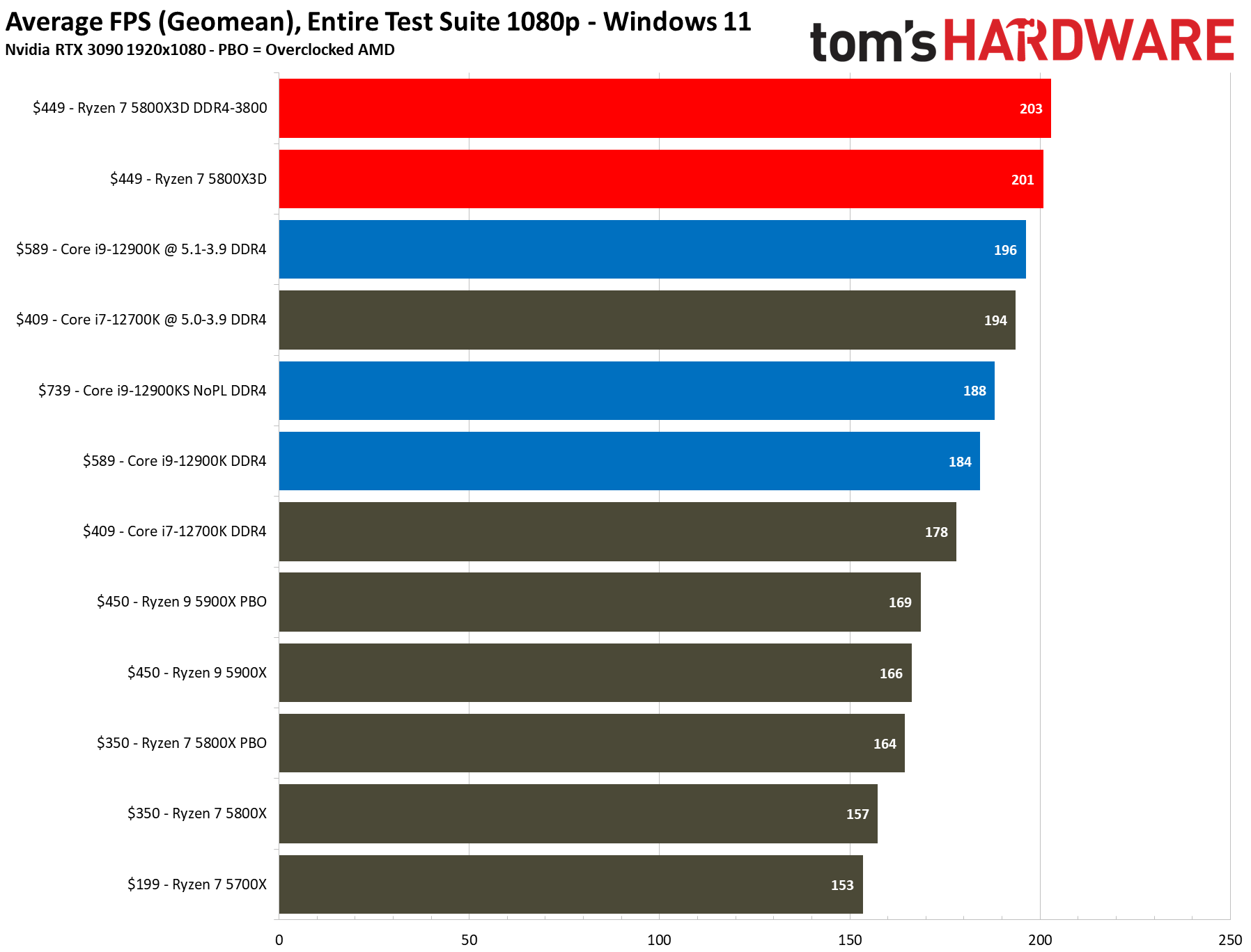

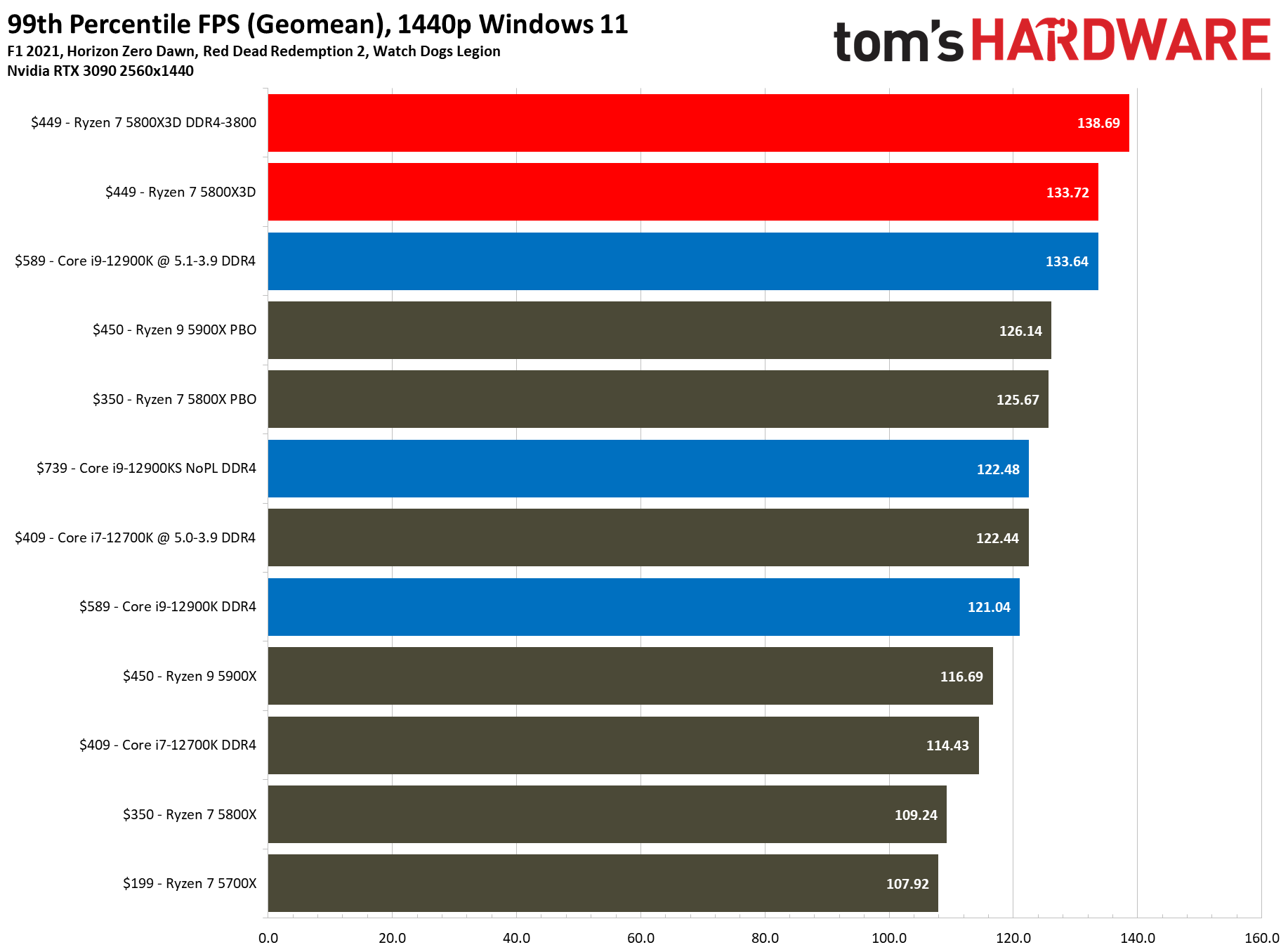
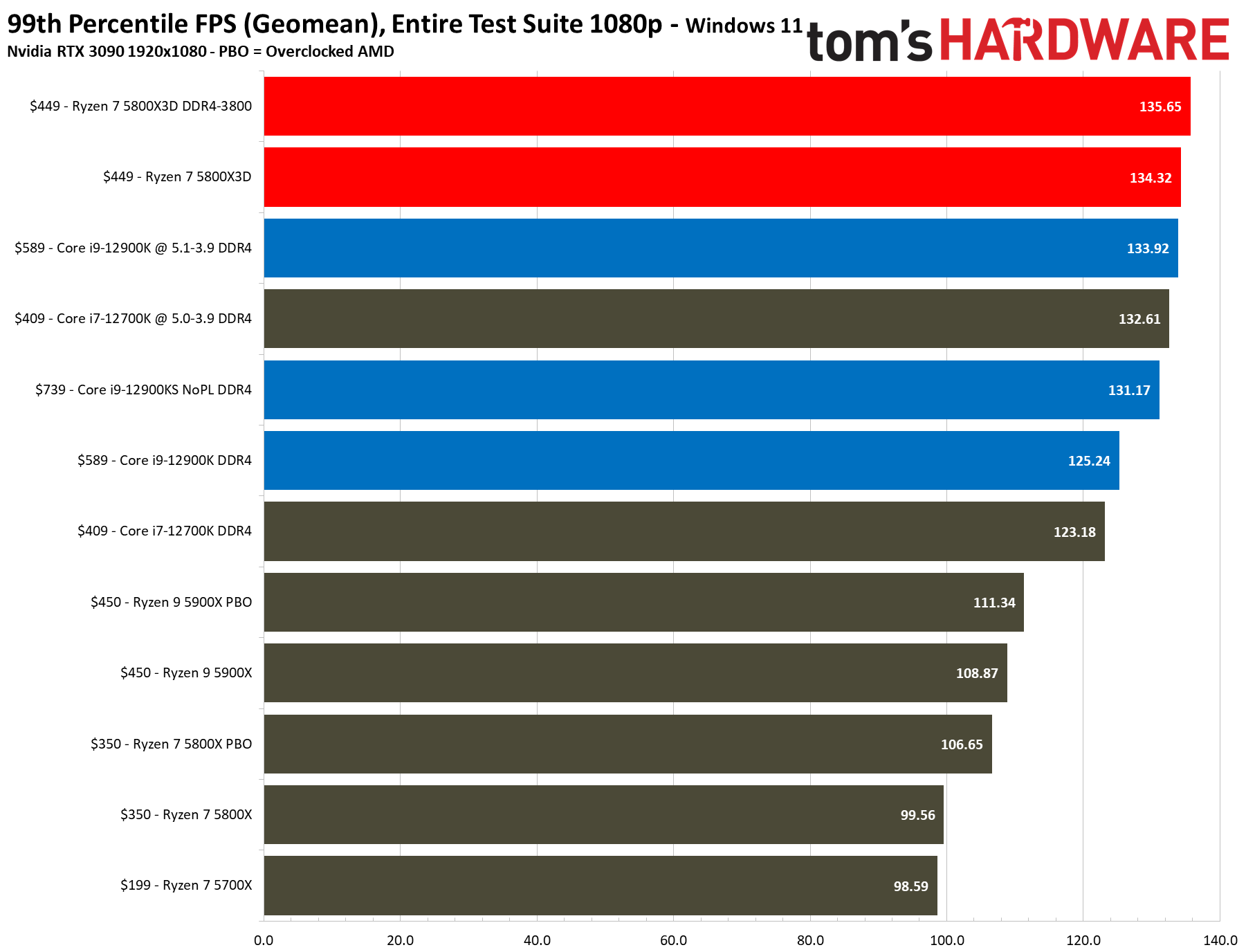


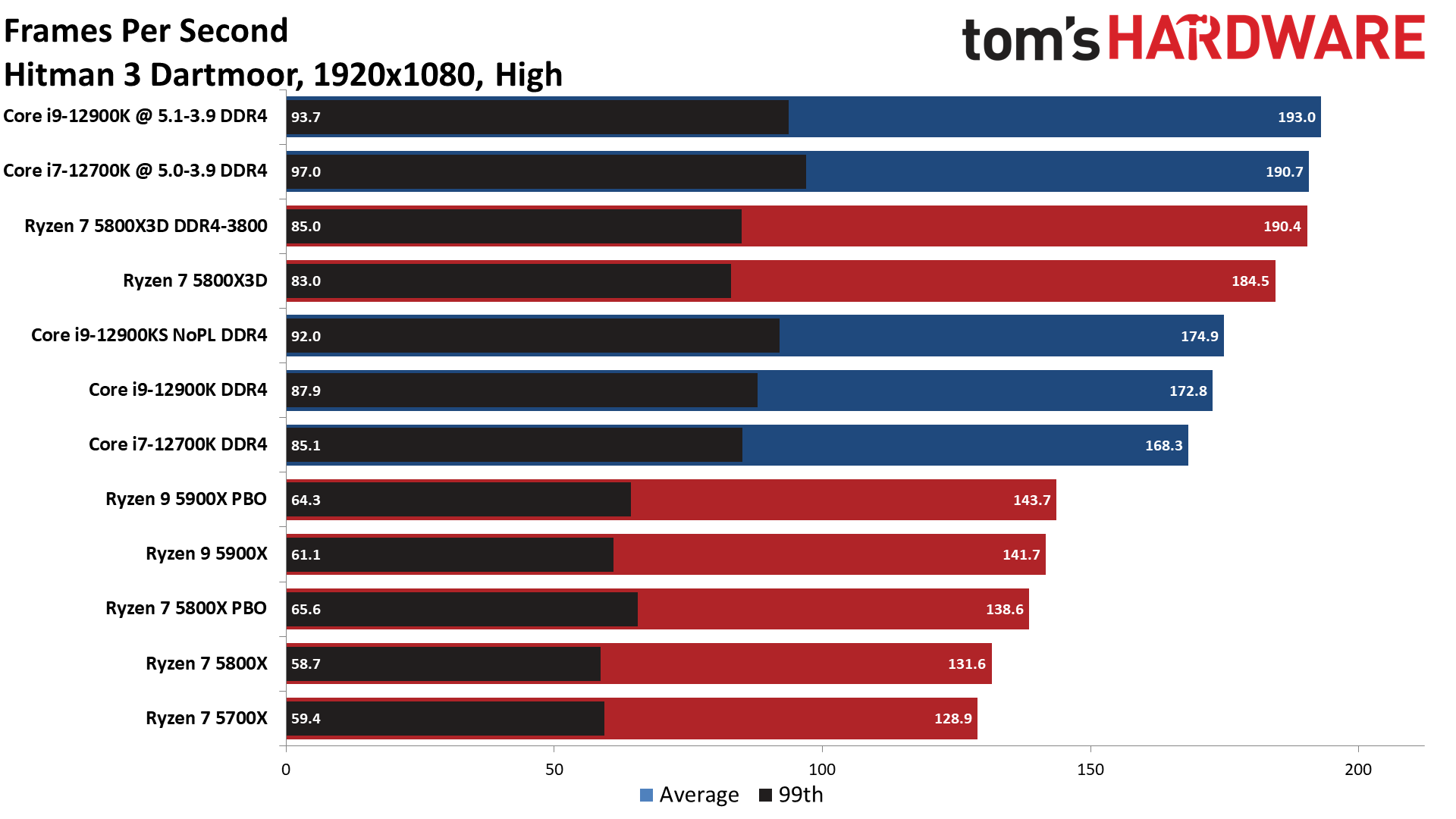
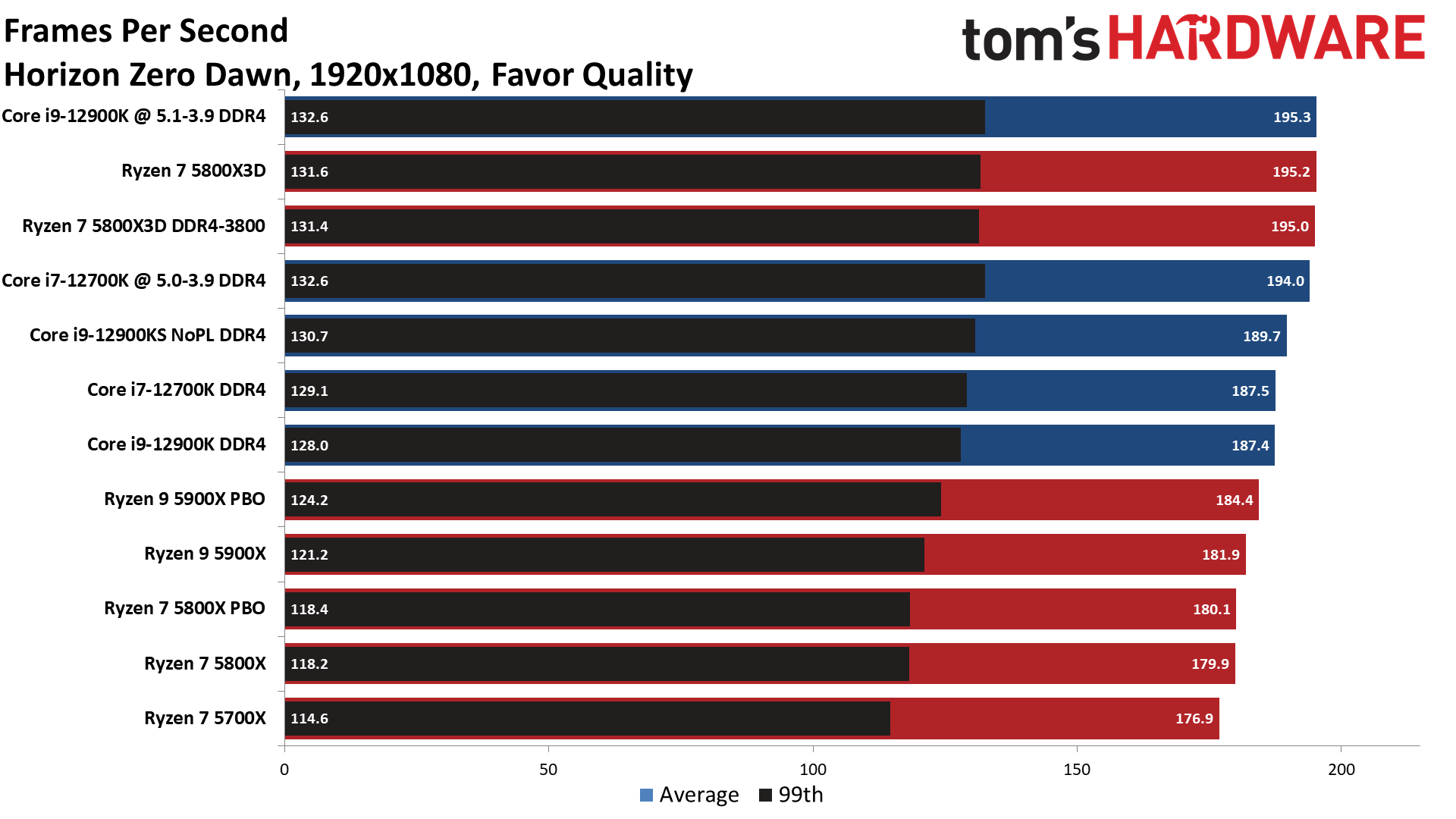
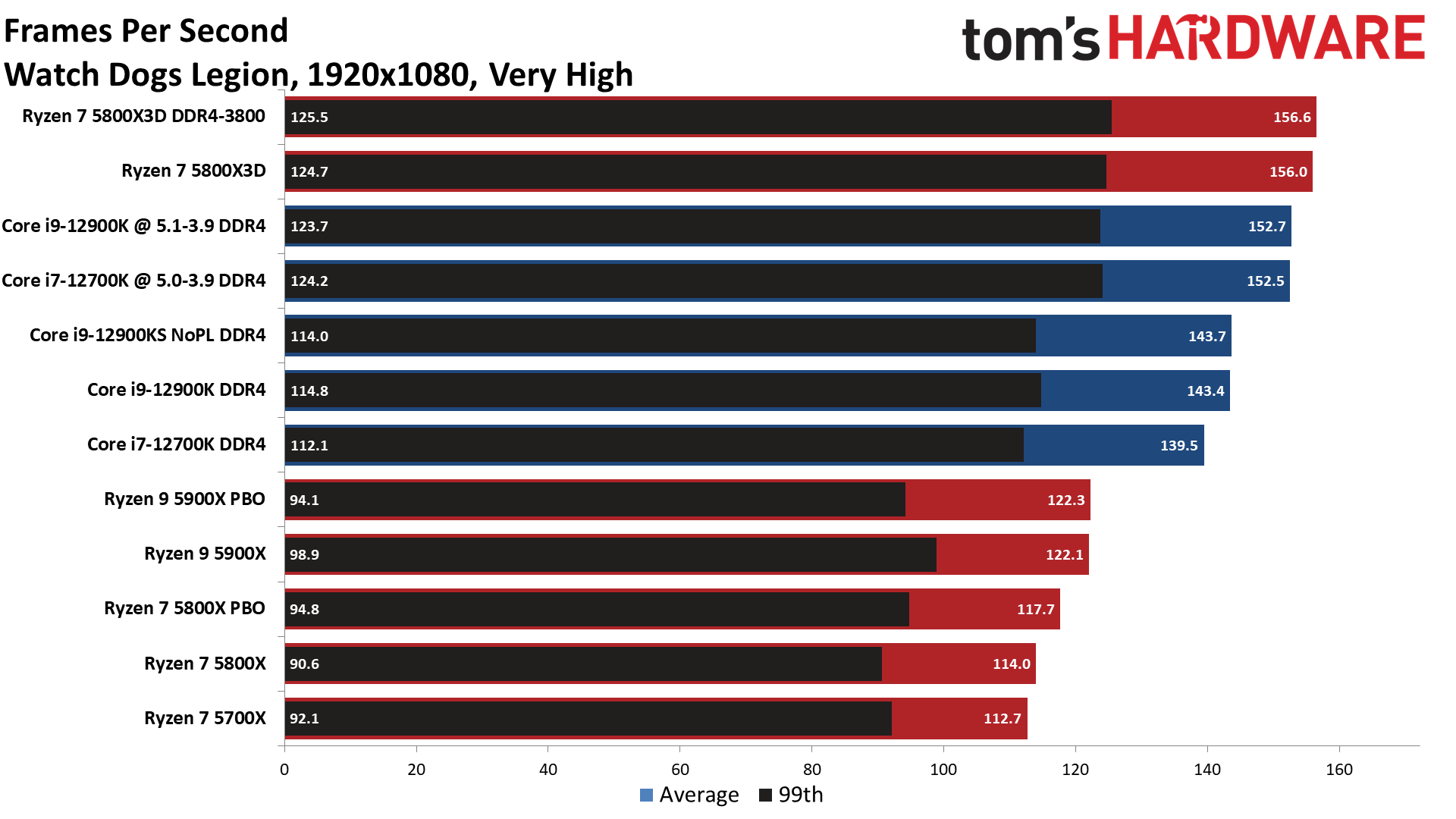
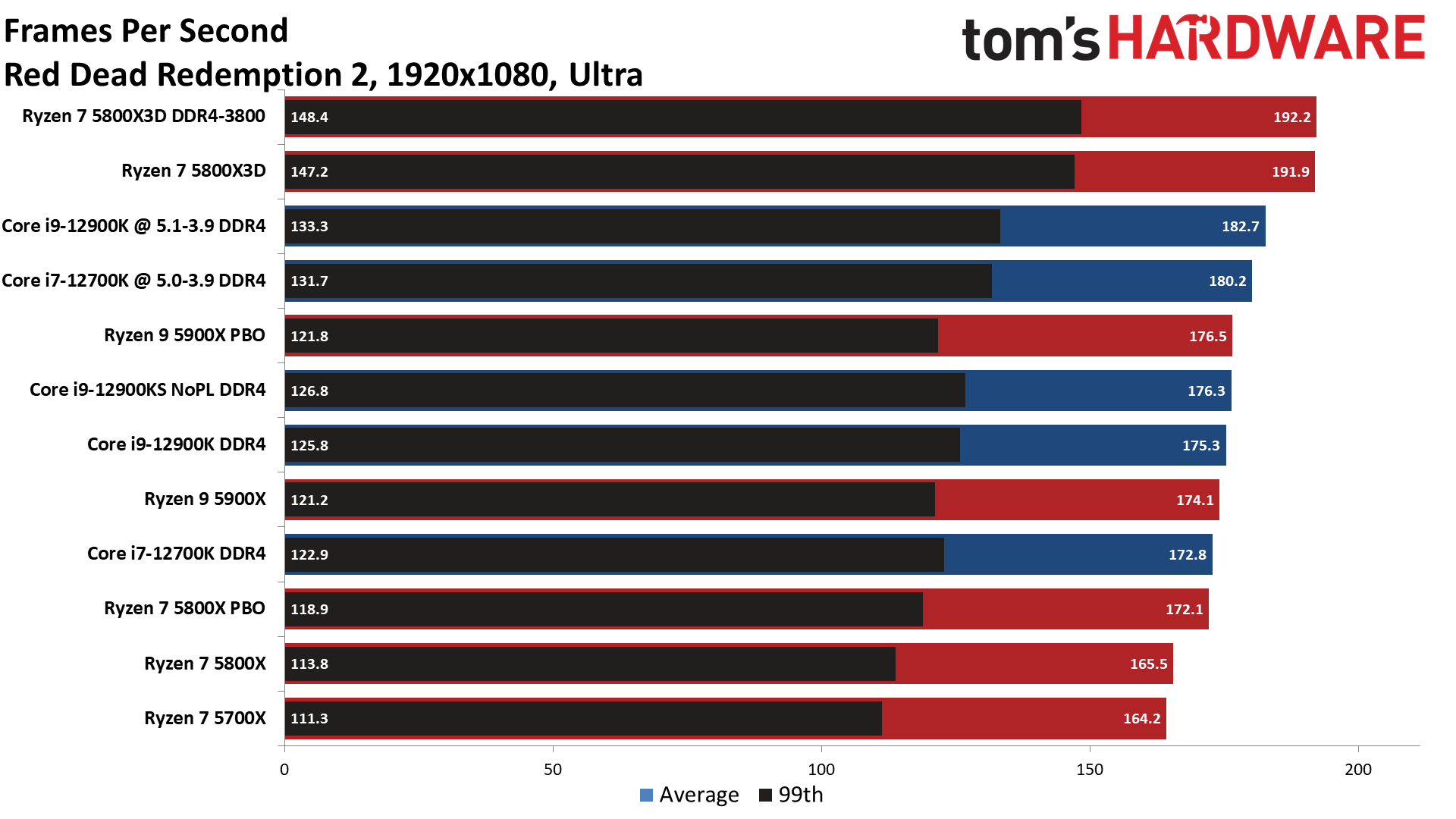
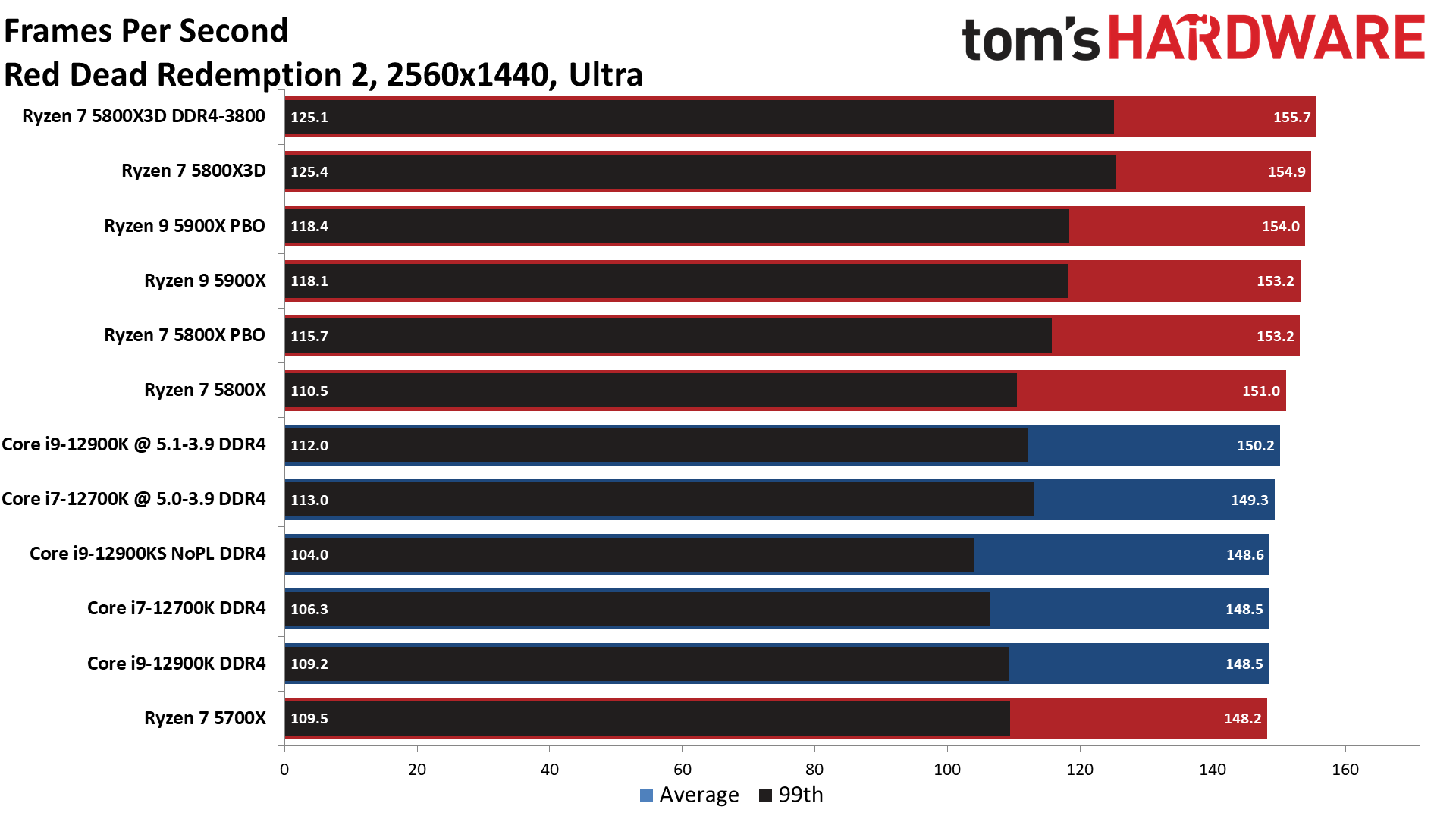
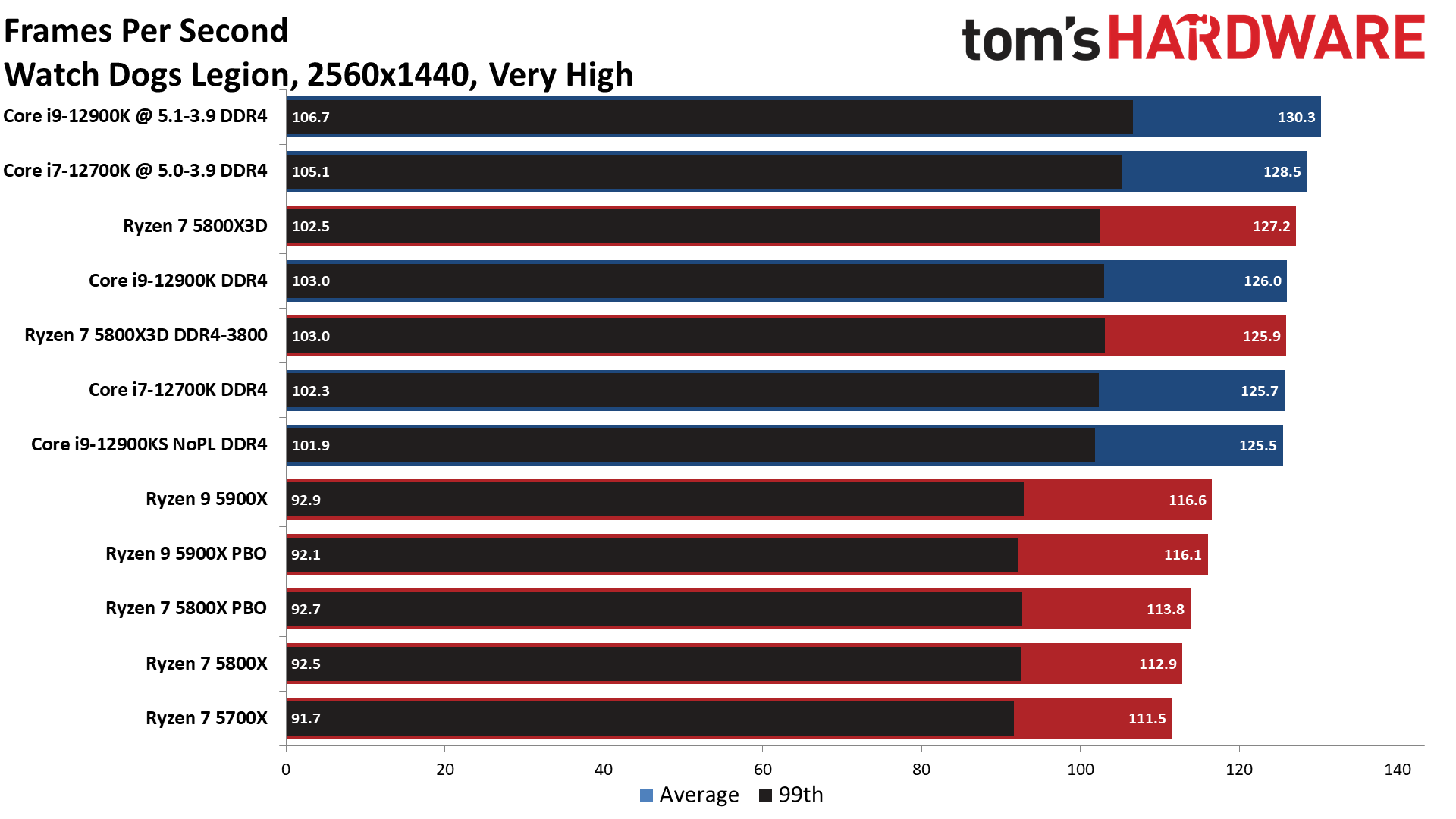
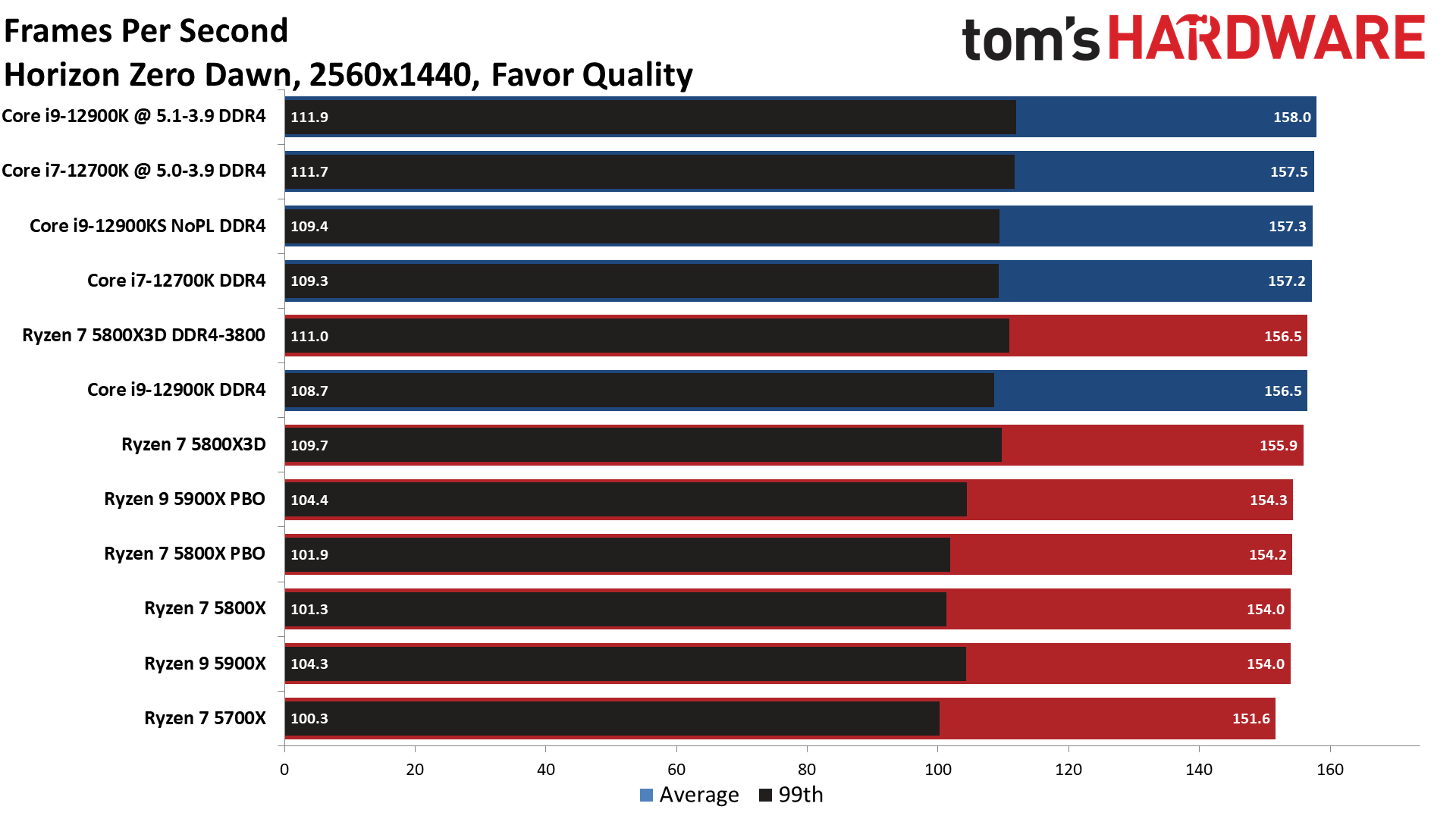
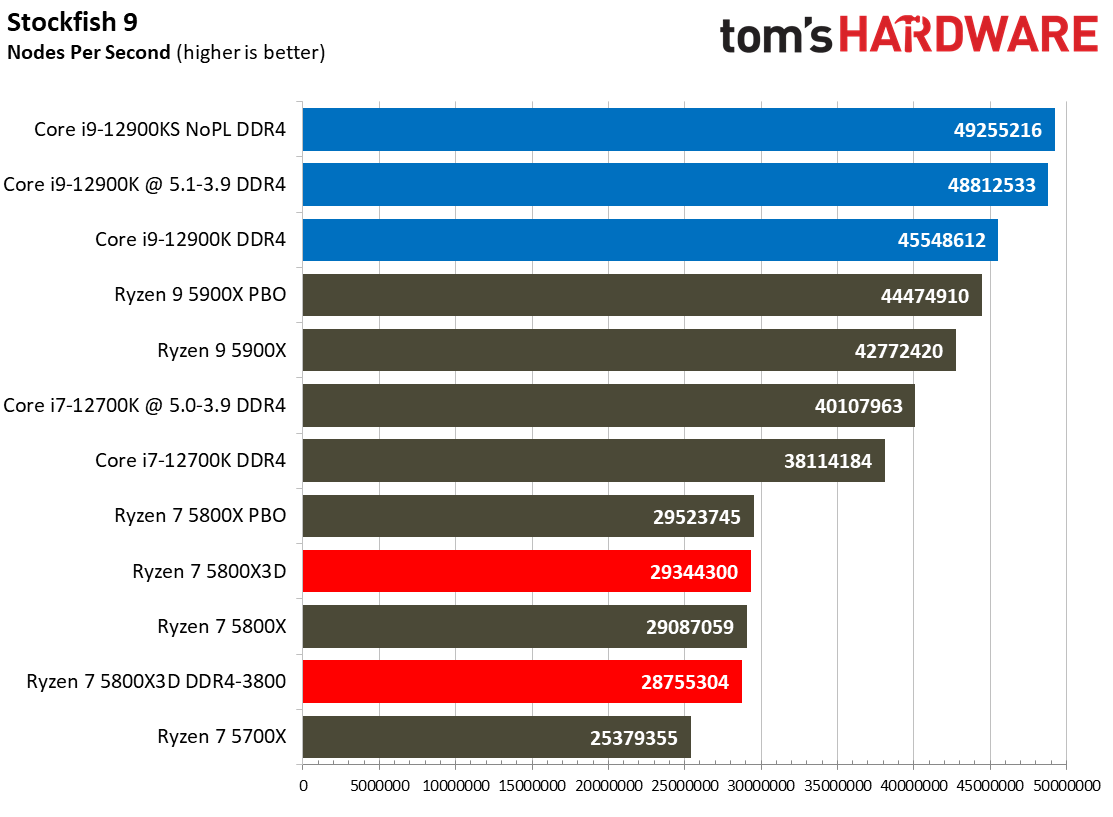


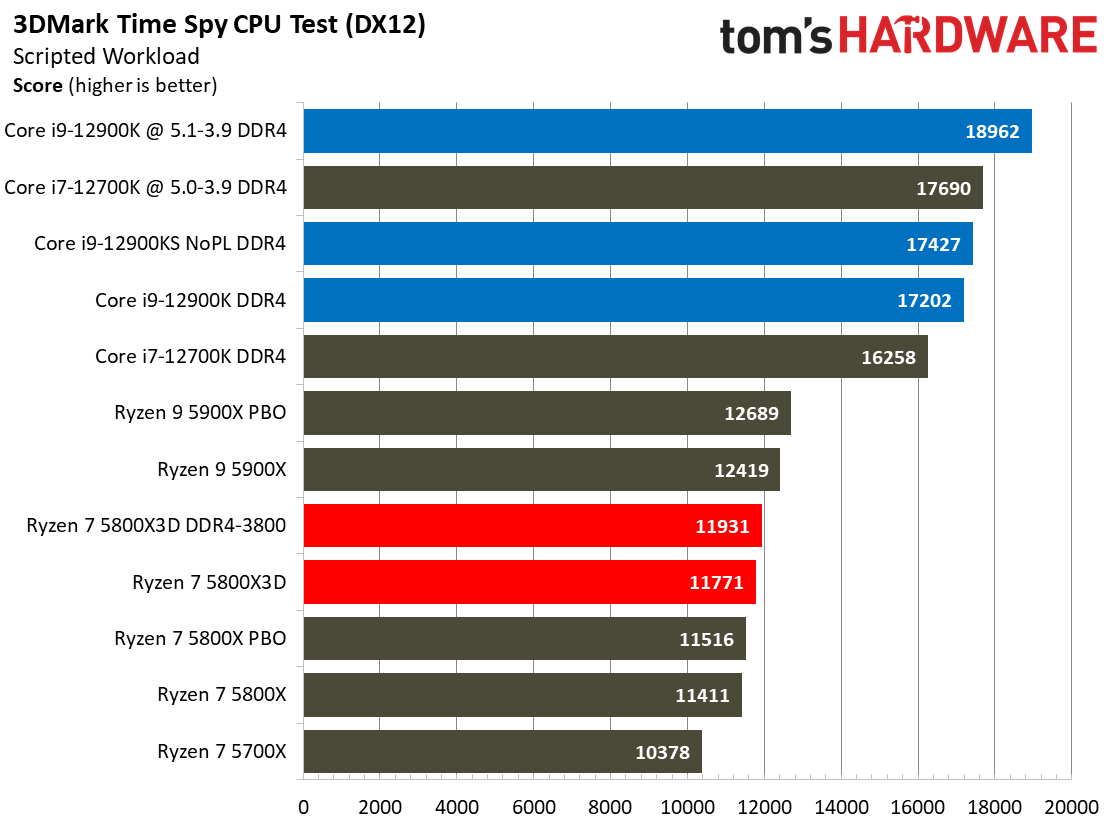

The first few charts above comprise the geometric mean of our standard gaming test suite, but we also include the individual game benchmarks. It’s important to remember that the Ryzen 7 5800X3D only accelerates some game titles; it really boils down to how much the game code prefers a spacious L3, so results could vary widely. As such, do your due diligence to ensure the chip accelerates the games you frequently play.
On average at 1080p, the 5800X3D is ~9% faster than the 12900K, which costs 30% more, and ~7% faster than the Core i9-12900KS, which costs a whopping 64% more. That means the Ryzen 7 58000X3D is both the fastest gaming chip in our test suite and a better value for gaming specifically than the Core i9 models.
Intel’s chips fully support overclocking, but the Core i9 models require a beefy cooler and robust motherboard. Despite its much tamer overall power requirements, the Ryzen 7 5800X3D is still ~3% faster than the overclocked 12900K in our cumulative measurement. For reference, we couldn’t overclock our 12900KS as high as the 12900K, so overclocking is still subject to the whims of the silicon lottery.
Overclocking the 5800X3D's memory yielded an average performance increase of only about 1%, which isn't too meaningful.
The 5800X3D is 13% faster at 1080p than the stock Core i7-12700K but is only 3.6% faster than the overclocked 12700K config. The Ryzen 7 5800X3D is 10% more expensive than the 12700K, but the more value-centric AM4 ecosystem gives AMD a leg up over Intel's chip, at least if you're specifically interested in gaming.
The competition between Intel and AMD is much closer now, and not all games benefit from the 3D V-Cache or Alder Lake’s hybrid architecture, so it's best to make an informed decision based on the types of titles you play frequently. Be sure to check out the individual tests.
Winner: AMD
The Ryzen 7 5800X3D delivers the types of gains in gaming performance that we would normally expect from a new architecture, but it comes via the tried-and-true Zen 3 architecture and 7nm process. You’ll need to weigh the types of titles that you play frequently, but the 5800X3D is faster than Intel’s finest while maintaining the pricing advantage.
It’s hard to argue that matching or beating the $783 Core i9-12900KS with a $449 chip isn’t impressive. You’ll just have to keep in mind that you’ll sacrifice plenty of performance in other types of applications compared to the Alder Lake chips, as you’ll see in the next series of tests.
Application Performance: Ryzen 7 5800X3D vs Core i7-12700K and Core i9-12900K
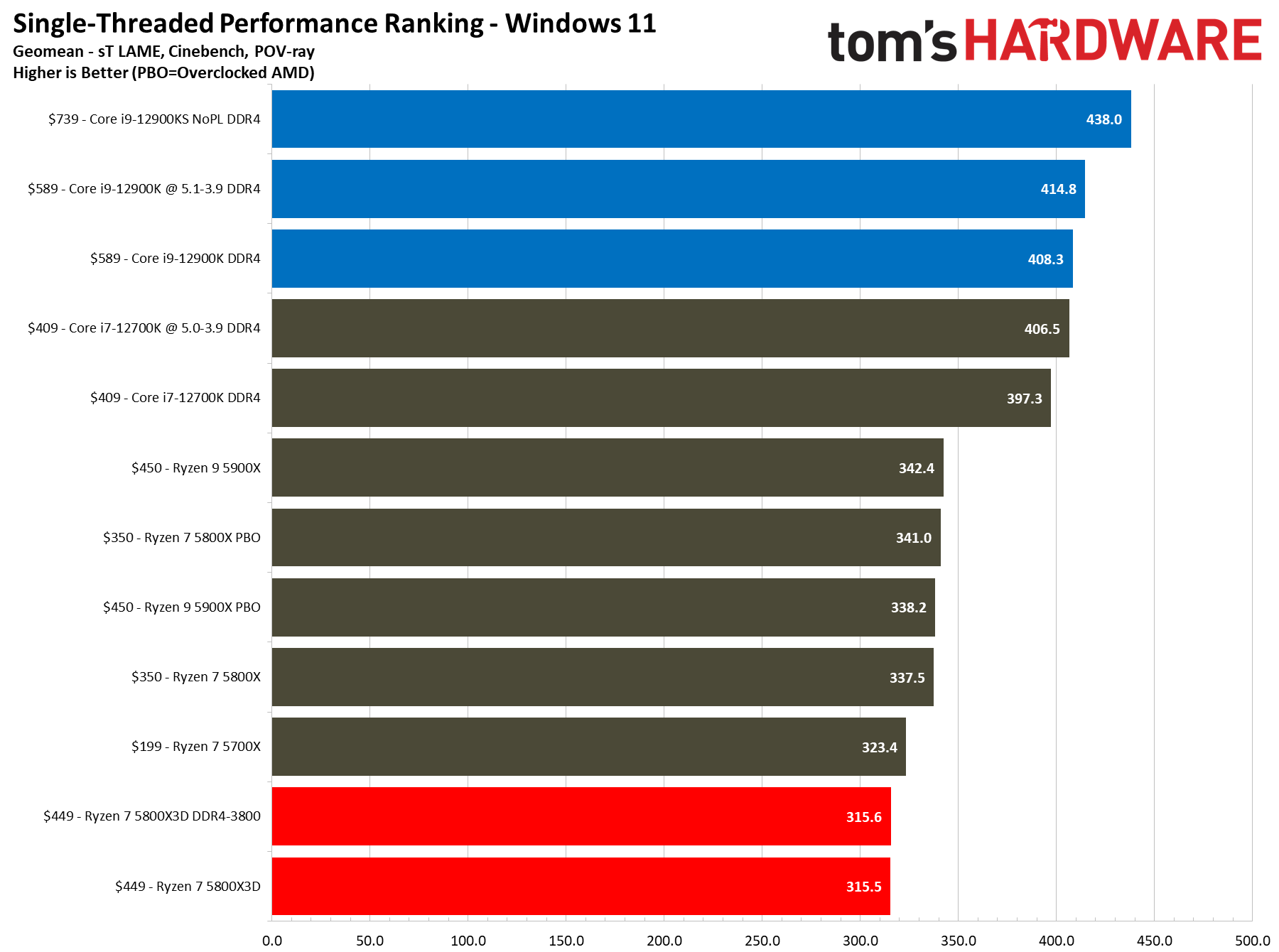
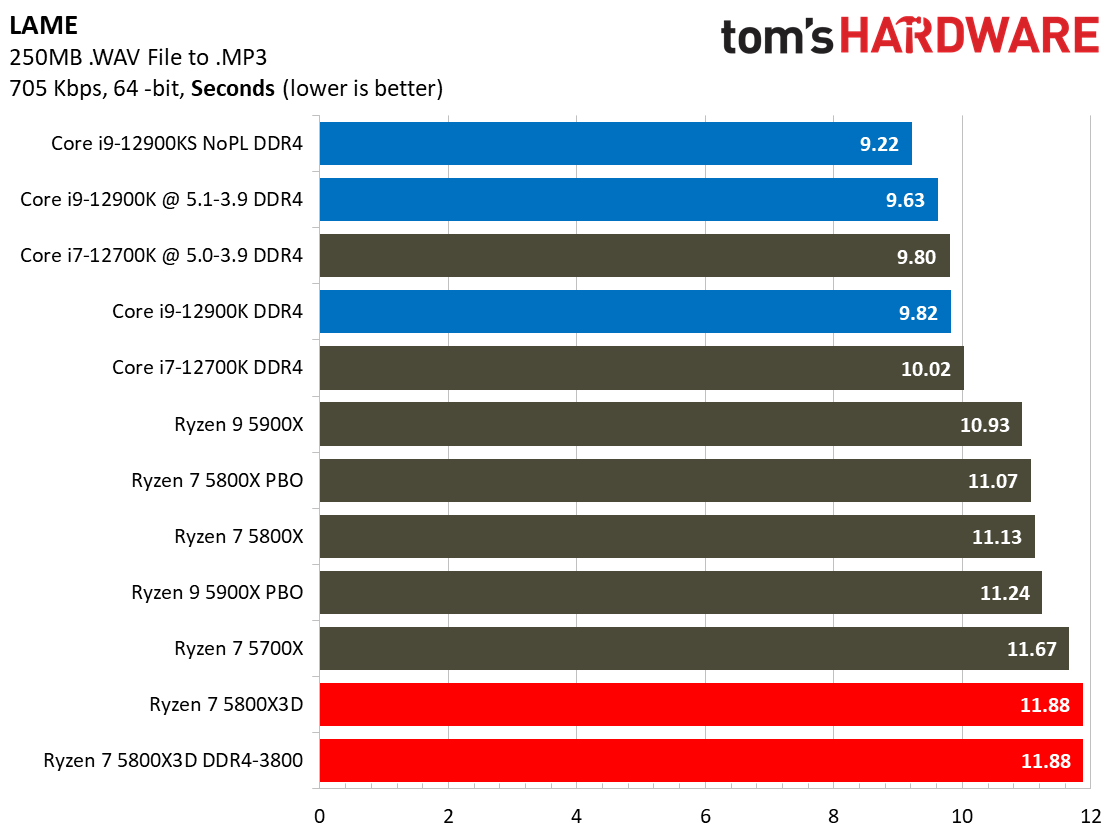
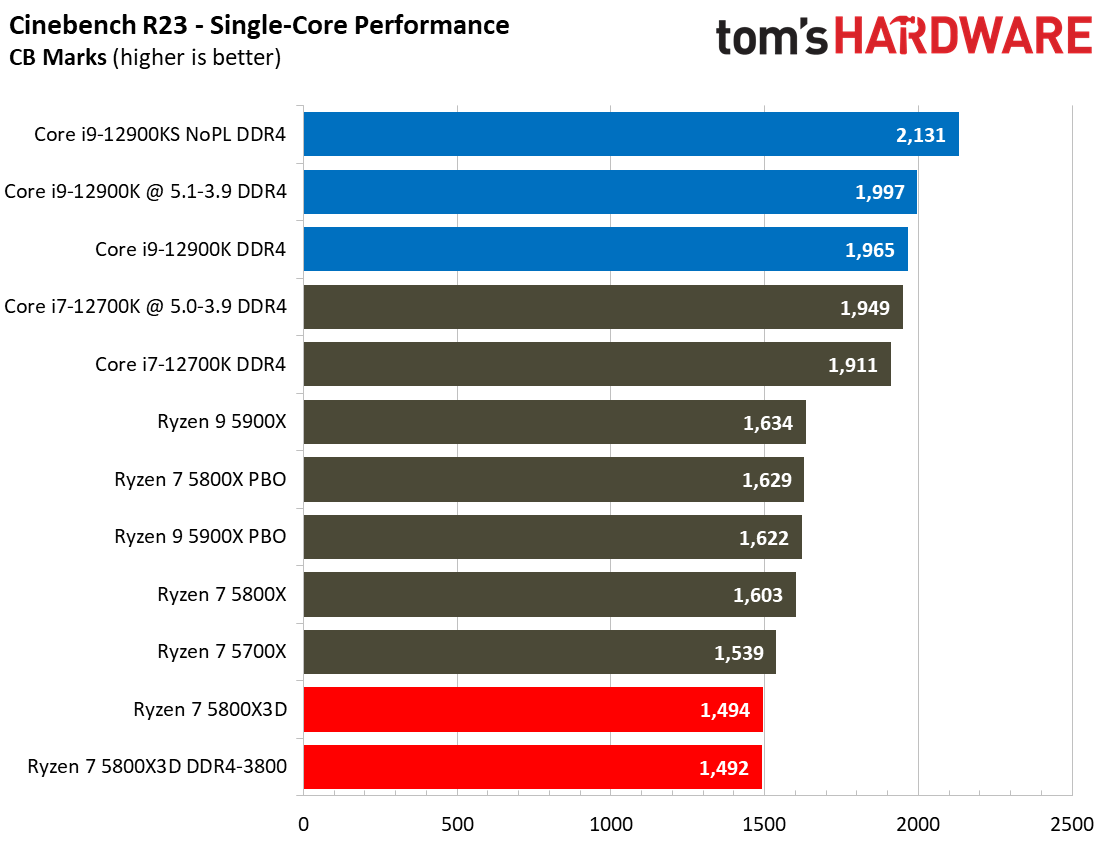

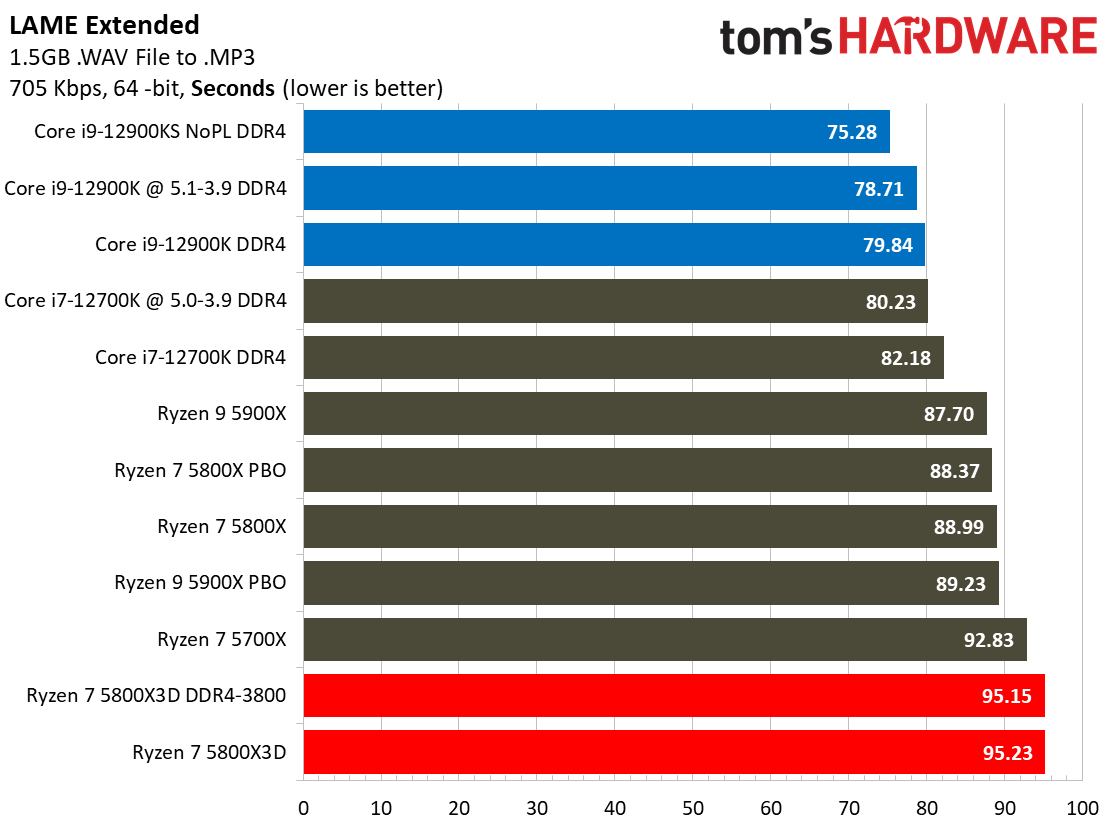

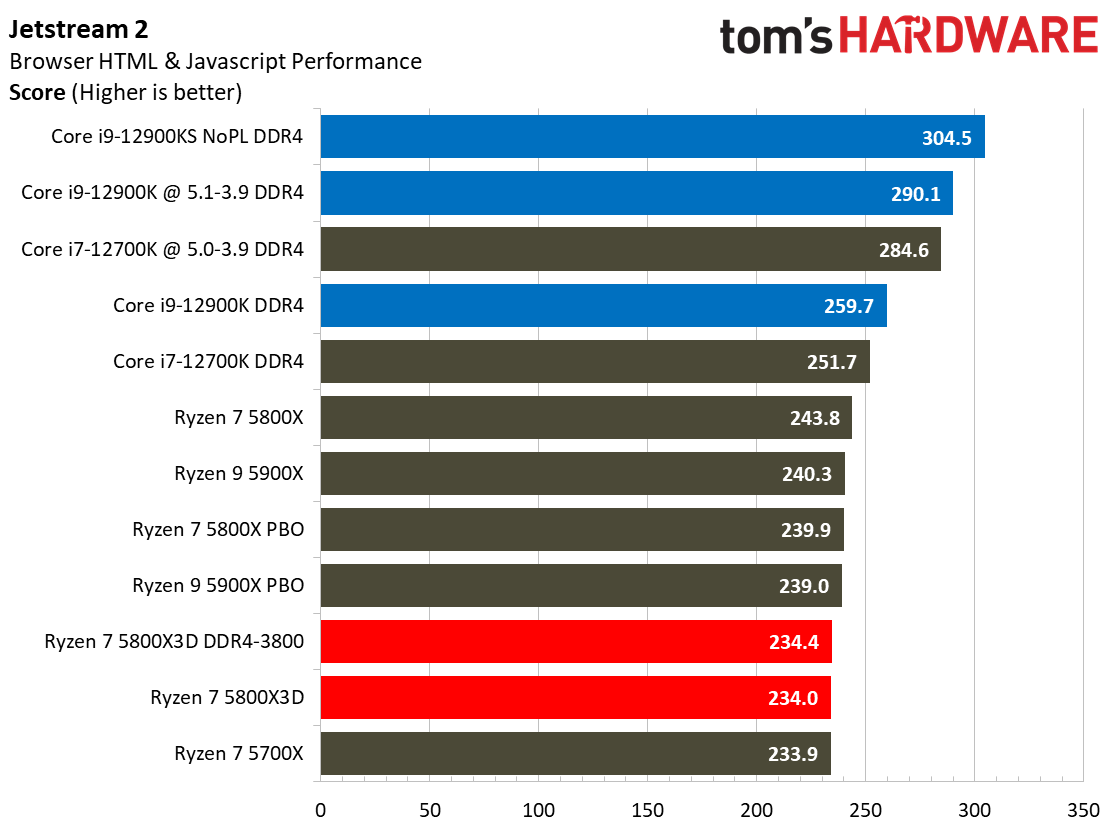
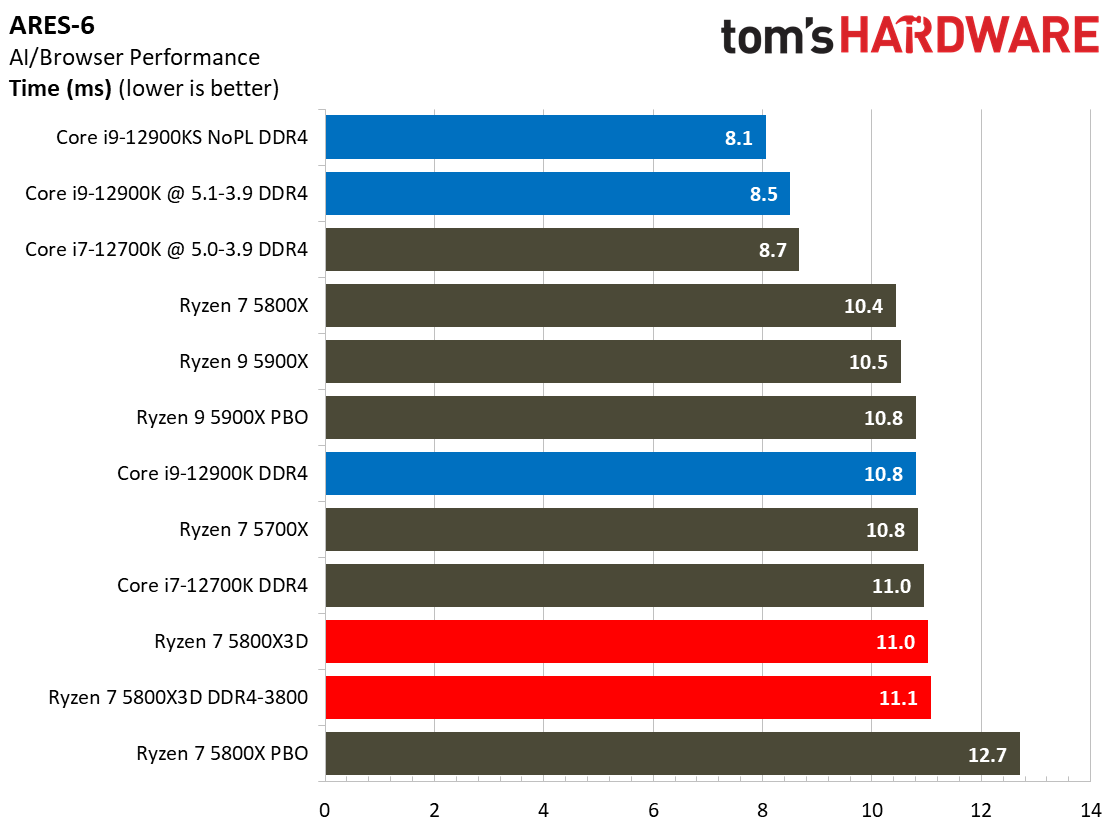
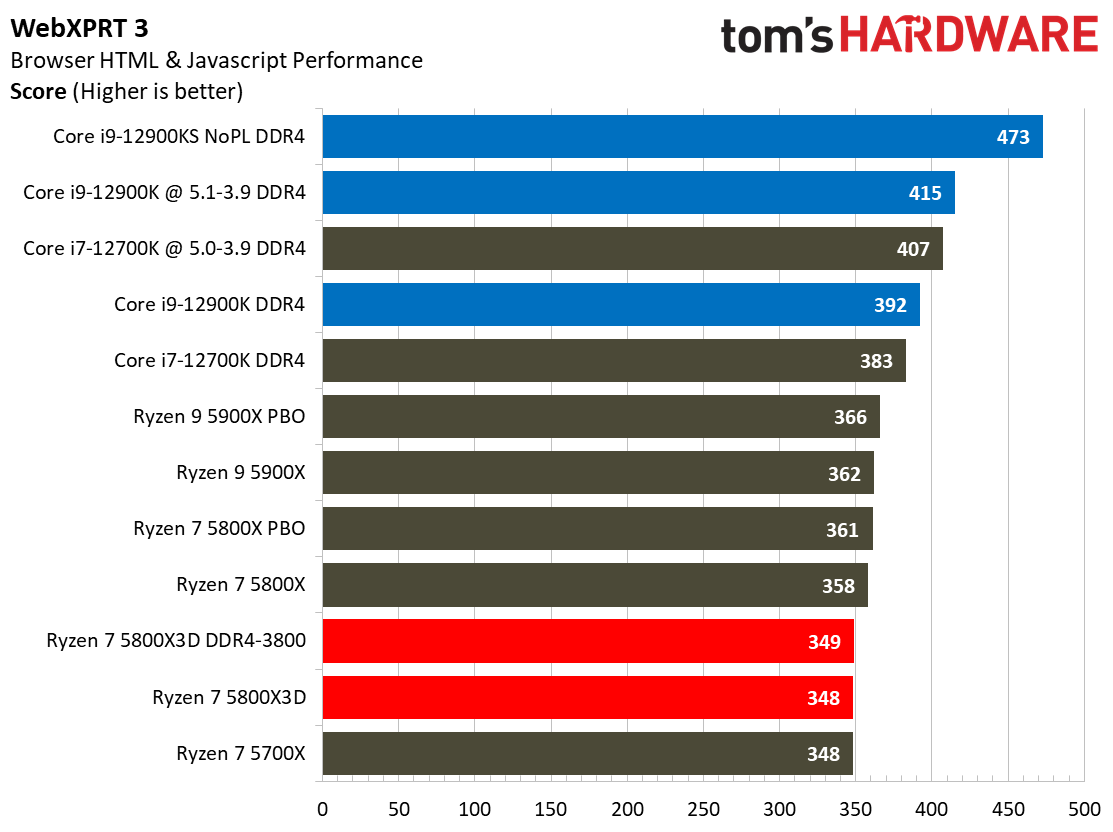

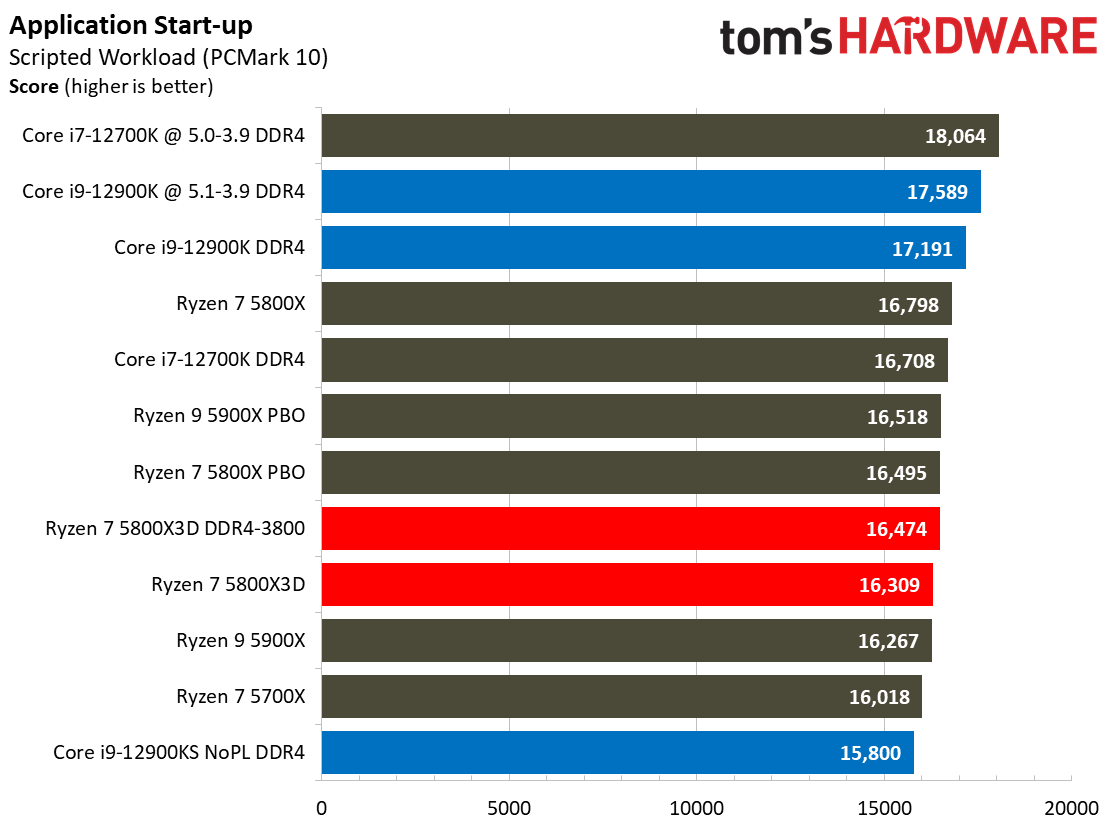
We can boil down productivity application performance into two broad categories: single- and multi-threaded. The first slide above shows the geometric mean of performance in several of our most important tests in each category, but be sure to look at the individual benchmark results in the deck.
After the commanding leads we saw in gaming, it's shocking to see the Ryzen 7 5800X3D’s bipolar performance trend when it comes to applications. Remember – the extra cache has little to no impact on performance in standard applications, and you lose some clock speed compared to the regular model. That gives the Ryzen 7 5800X a 7% lead in single-threaded work, while the 5800X3D trails the entire test pool.
The 12900K is 29% faster than the 5800X3D in single-threaded work, and that lead grows even larger with the Core i9-12900KS. However, given its $409 price point, the Core i7-12700K really shines in comparison to the 5800X3D – it’s 28.8% faster in single-threaded work, highlighting that Intel’s Alder Lake is exceptionally performant in latency-sensitive application work like web browsers and application startup times.
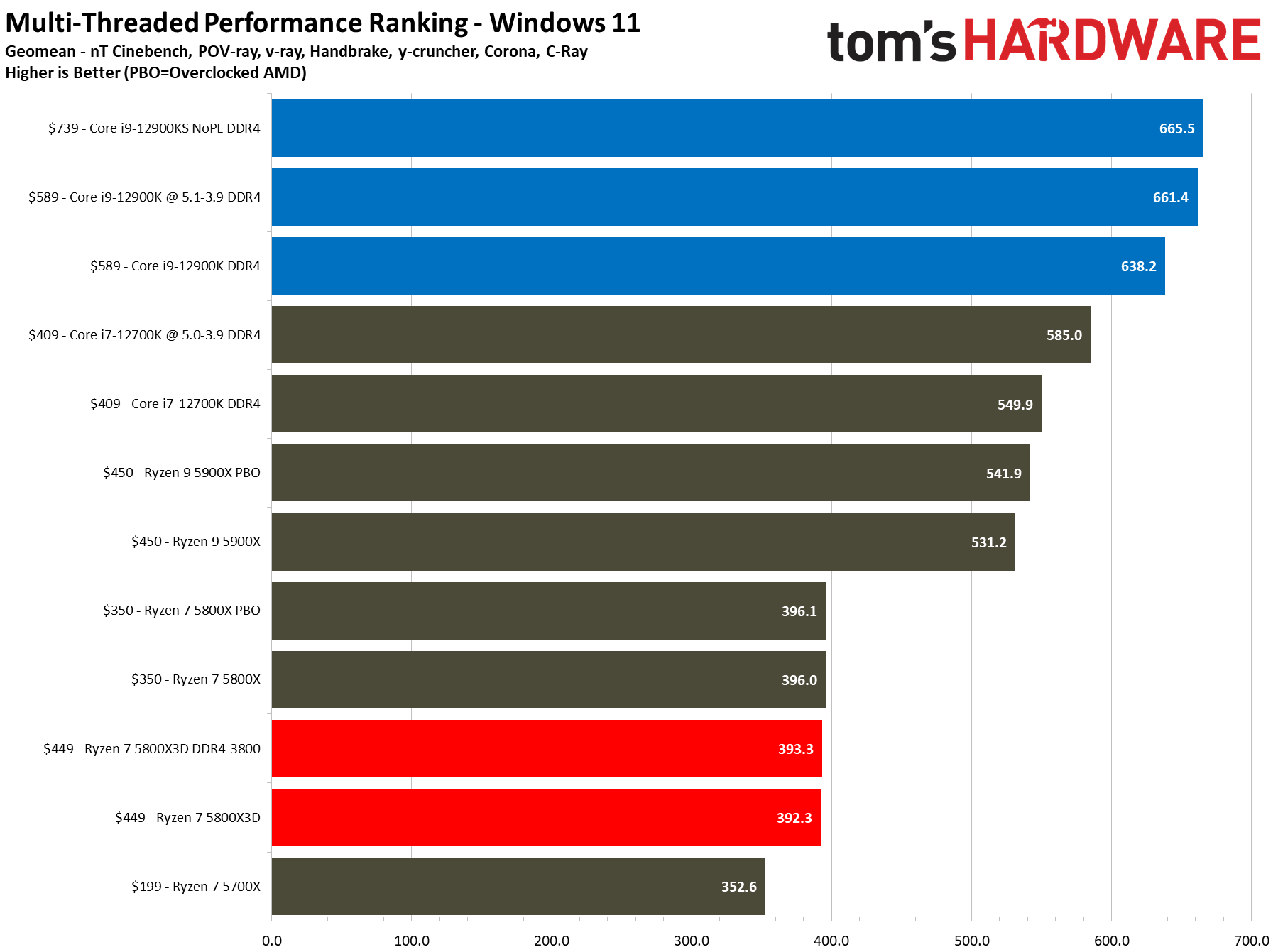
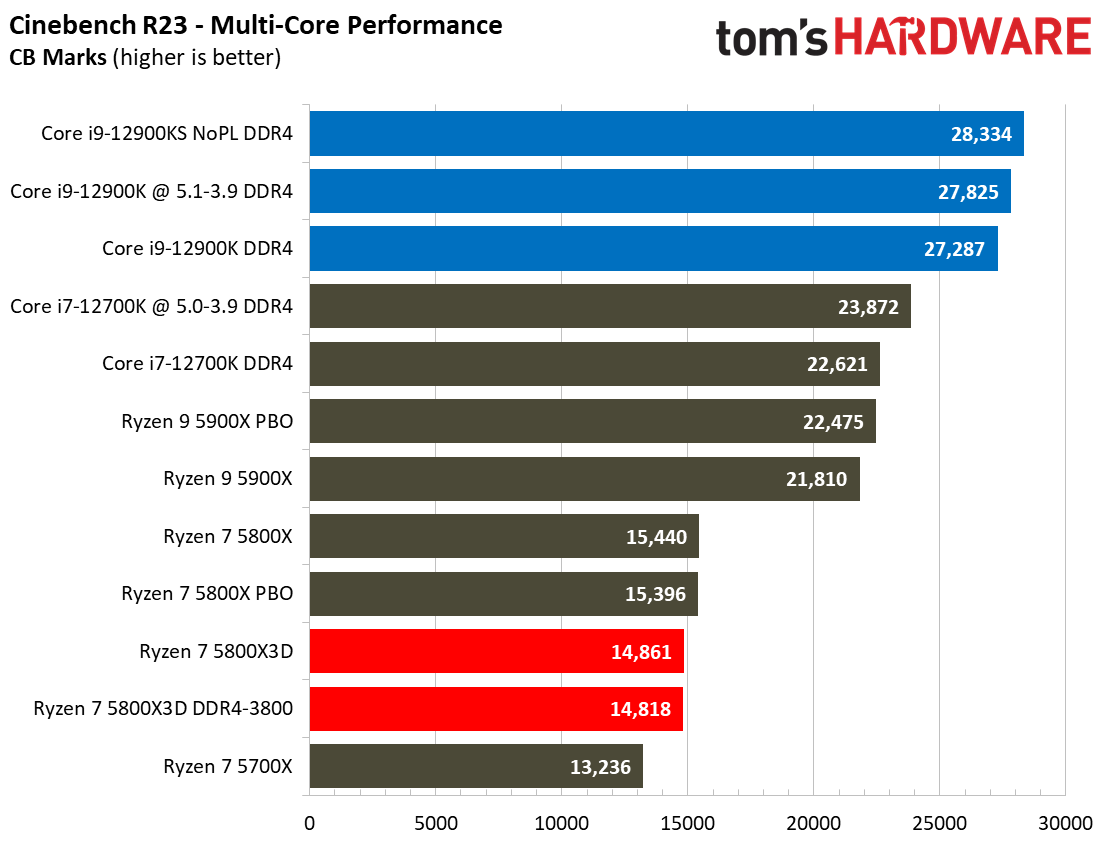

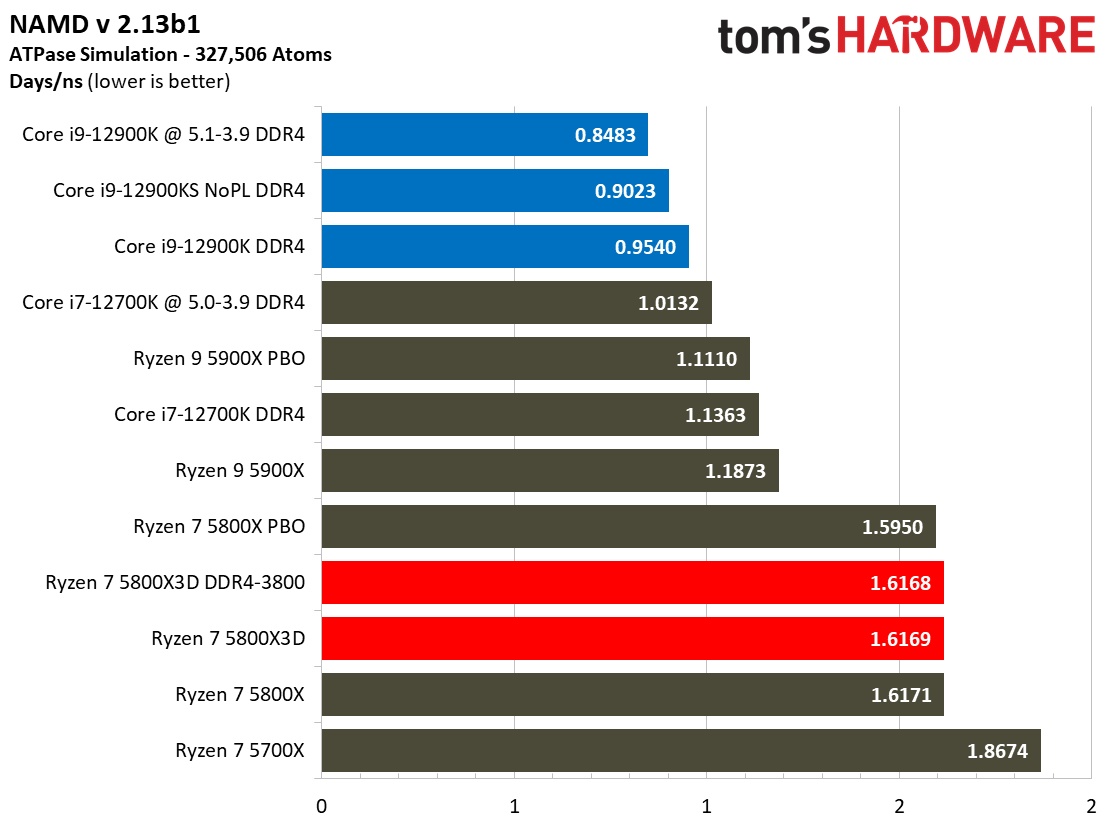
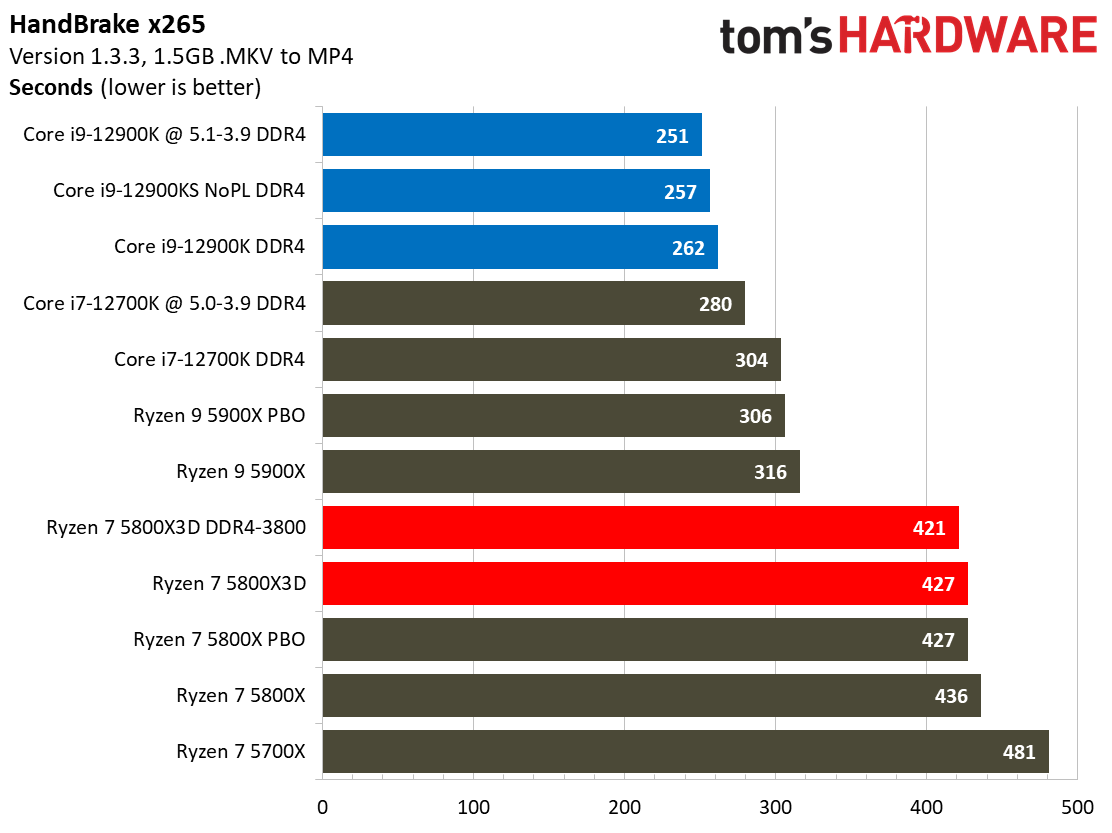

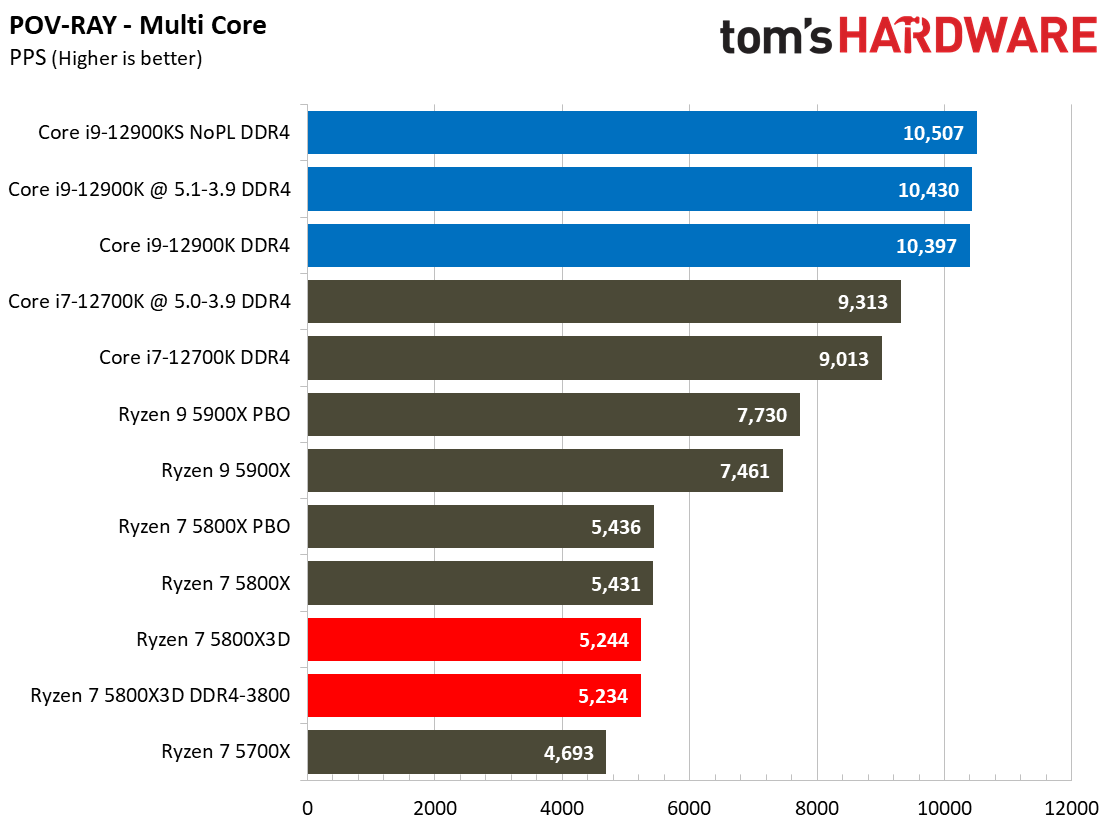
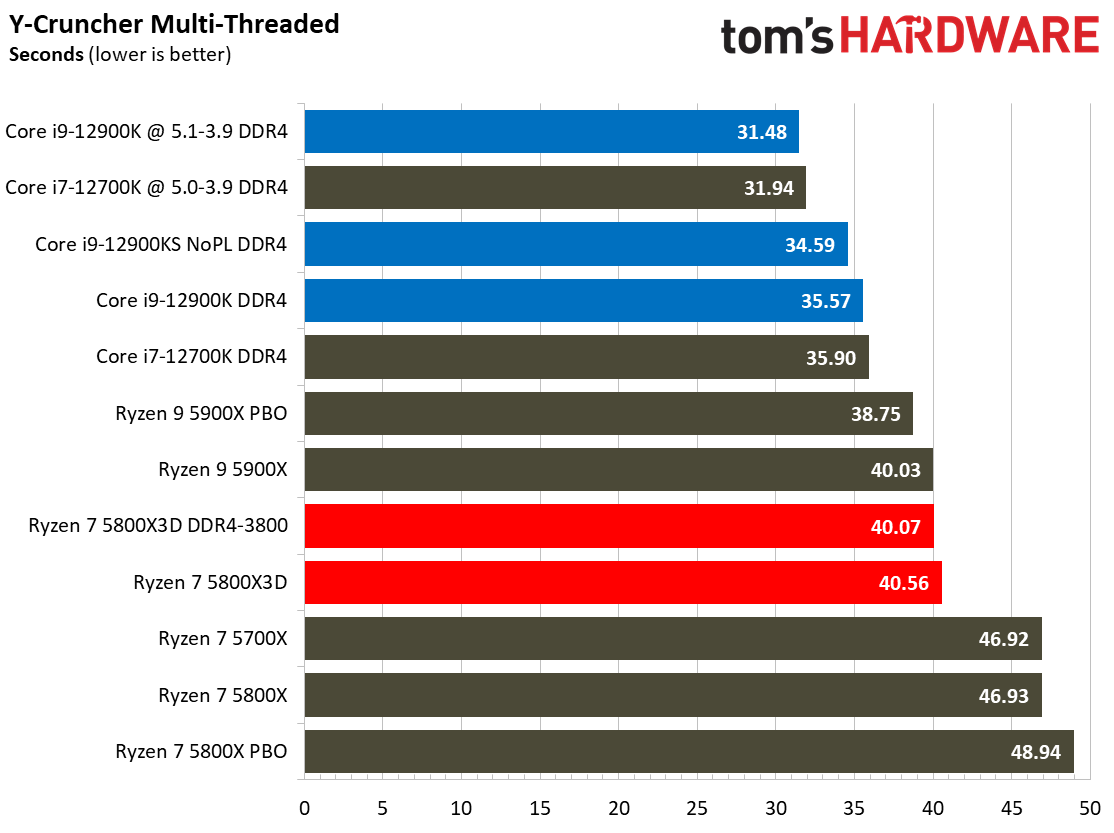
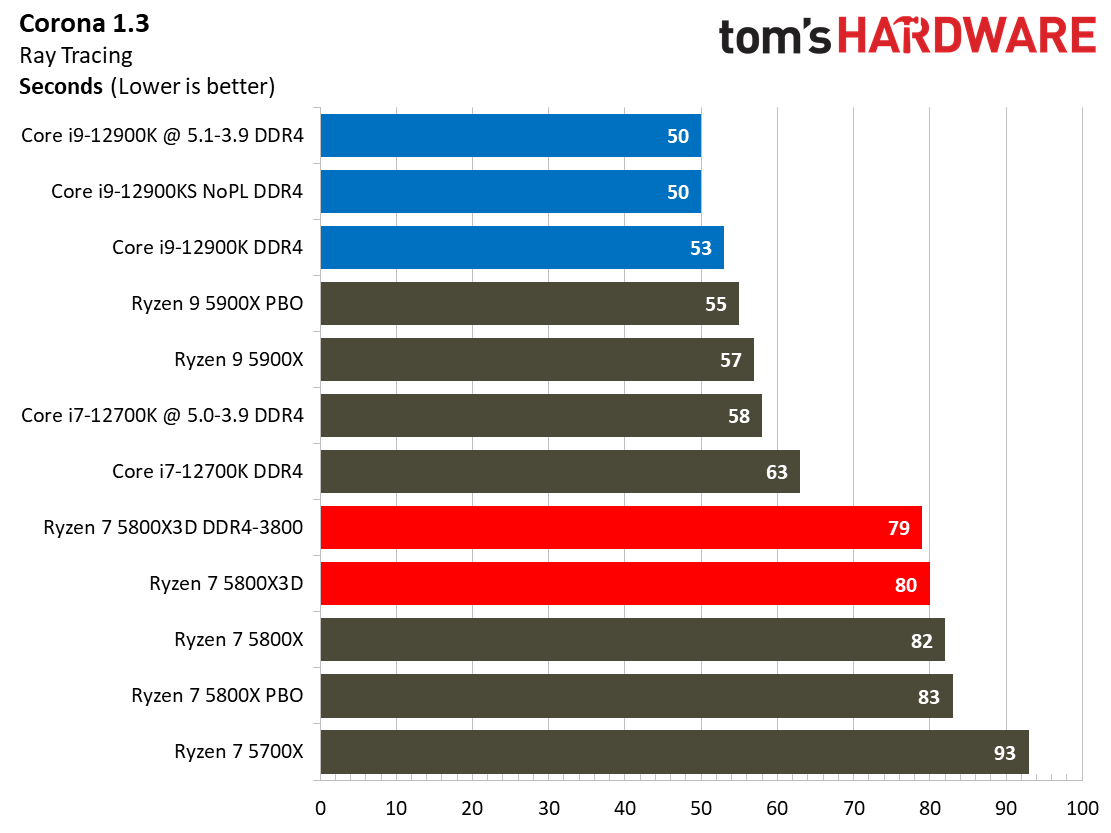
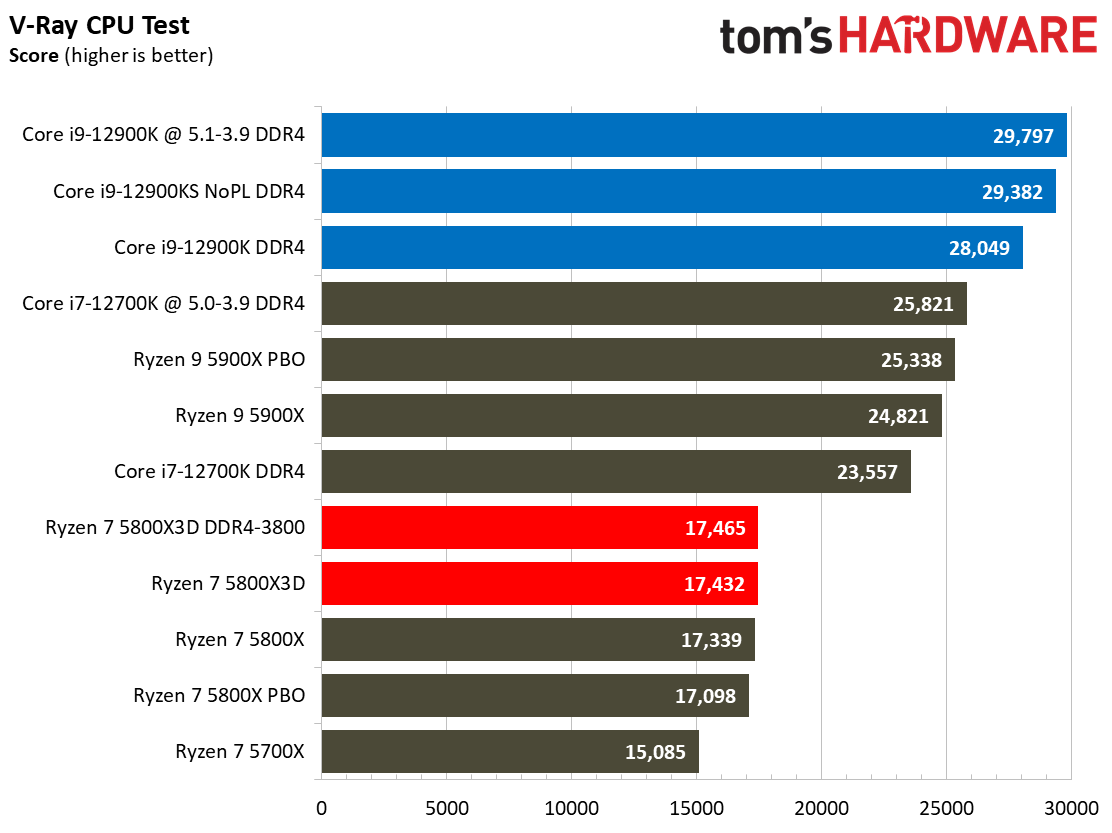
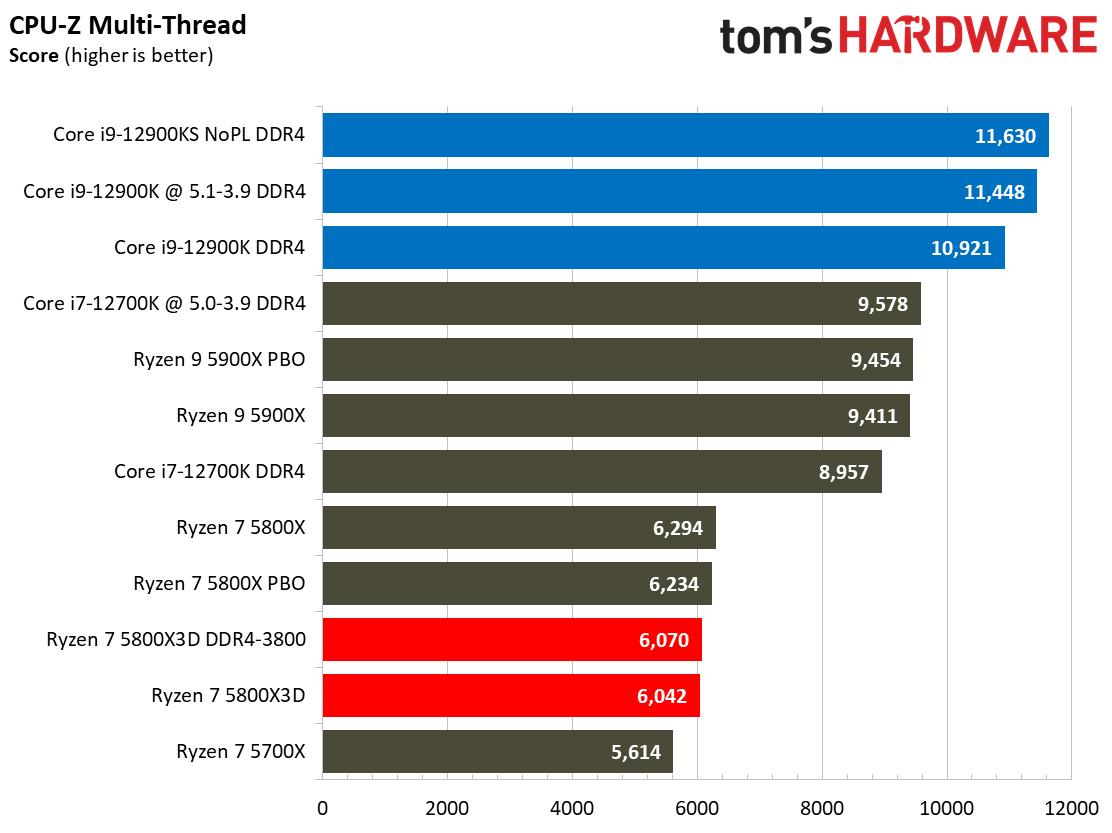


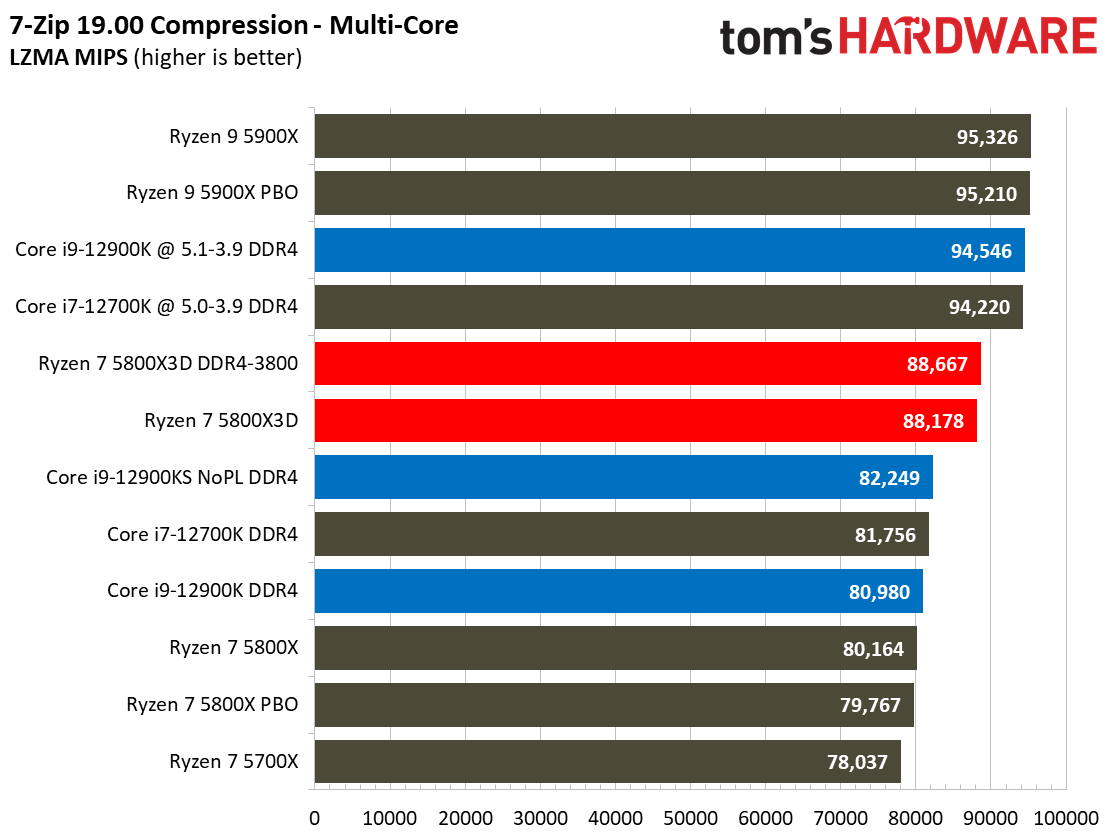
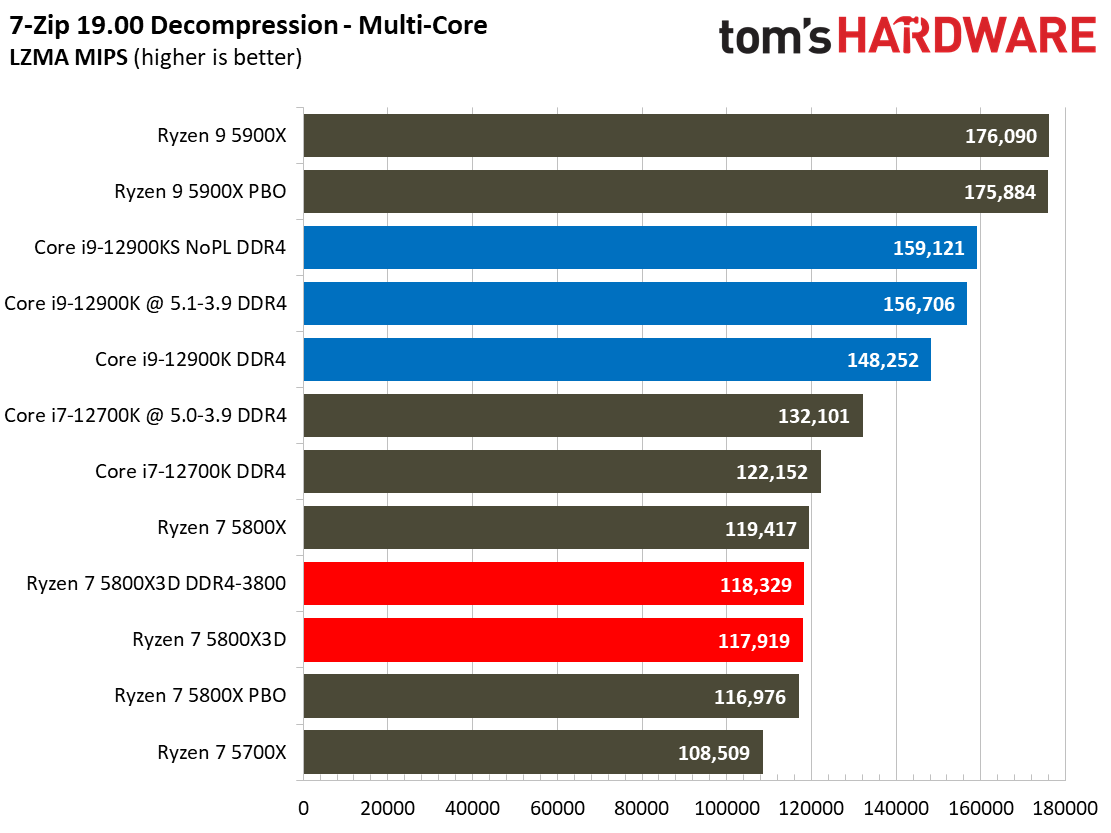
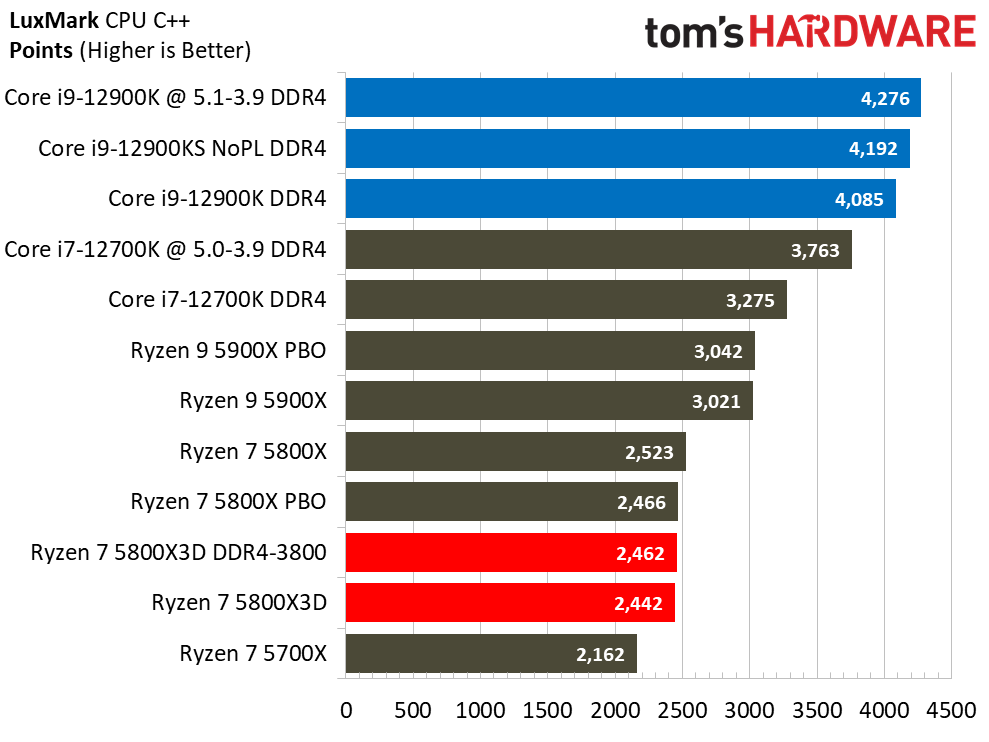
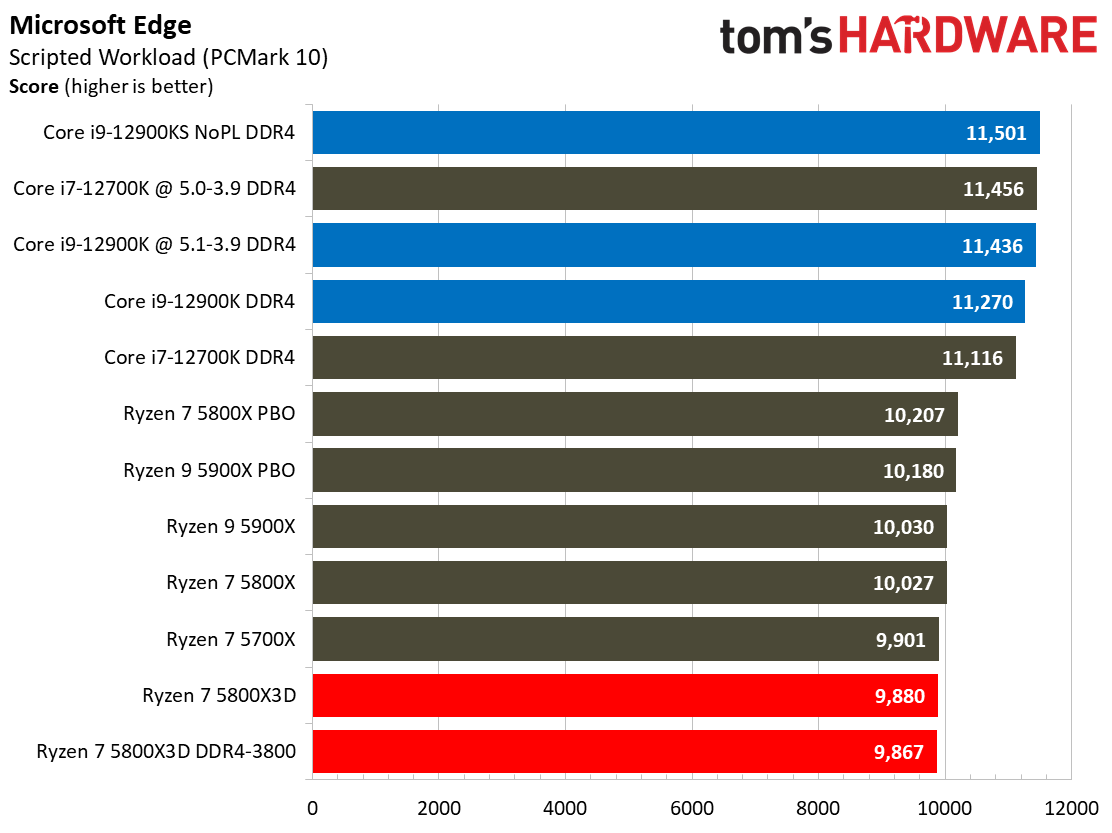
The Ryzen 7 5800X3D offers decent multi-threaded performance, meaning it could more than handle most users’ common threaded use-cases, like streaming while gaming, but it can’t keep pace with the Intel competition in the heaviest work.
The Core i9-12900K is 62% faster in threaded applications than the 5800X3D, while the Core i7-12700K is 40% faster in multi-threaded work, showing that it is the best all-rounder in this price range. The Ryzen 7 5800X3D clearly isn't focused on performance in applications outside of gaming, so the results you’ll see throughout the above album are fairly predictable.
Winner: Intel
Our benchmarks clearly show that the Ryzen 7 5800X3D is a chip designed specifically for gaming, not for leading-edge performance in application workloads. The 7nm process paired with the Zen 3 architecture has proven to be a powerful contender in the past, but Alder Lake takes single-threaded performance to another level via its faster IPC and clock speeds. Meanwhile, the addition of the small E-Cores has paid off for Intel in threaded work, giving it the lead.
AMD’s 3D V-Cache is transformative, but it’s also expensive, leaving the 5800X3D competing against Intel’s more powerful chips. You’ll need far more powerful Ryzen 5000 chips to hang with the 12700K, while the 12900K beats AMD's finest.
Get Tom's Hardware's best news and in-depth reviews, straight to your inbox.
Overclocking: Ryzen 7 5800X3D vs Core i7-12700K and Core i9-12900K
As mentioned, the Ryzen 7 5800X3D doesn't support overclocking via the CPU multiplier, so you can't change the core clocks via that method. You also cannot adjust the power limits (PPT, TDC, EDC) or CPU voltage. Additionally, the chip doesn't support the auto-overclocking Precision Boost Overdrive (PBO) feature, and you can't undervolt or underclock.
AMD says this is the result of voltage limitation, but our thermal testing in our review certainly implies that heat dissipation is an exacerbating issue. AMD says this is the first iteration of the tech, and it is possible that overclocking could be enabled on potential future 3D V-Cache processors.
That hasn't stopped adventurous enthusiasts from trying to overclock the 5800X3D, though. It is possible to engage in limited BCLK overclocking that can eke out extra megahertz, but bear in mind that any significant alterations will require you to disable certain PCIe devices, which we consider extreme measures that aren’t practical for regular use. Workarounds can also alter the motherboard's voltage output to the CPU, thus feeding the chip more voltage than AMD intended. Of course, the latter could incur significant risk, and we’ve already heard plenty of stories of rampant stability issues when using any of these tactics. We’re no strangers to taking risks when overclocking, but the risks seem awfully steep for the 5800X3D, given there’s very little real performance payoff if you're not chasing world records.
Memory overclocking doesn’t really help, either. Yes, the 5800X3D fully supports overclocking the memory and Infinity Fabric, but as with most Ryzen chips, we could only reach DDR4-3800 with the fabric dialed in at 1900 MHz. This setting allows us to run the memory in the desired low-latency 'coupled' (1:1 ratio) mode. However, as we’ve seen, you won’t get very meaningful performance improvements by turning the dial – we saw a ~1% improvement after tuning. It seems the large L3 cache works so well that it obviates the need for faster memory, so sticking with a cheap DDR4-3200 kit with tight timings is your best bet.
Intel exposes a wealth of tunable parameters with Alder Lake K-series models and the XTU software overclocking utility. Intel also supports per-core frequency and hyper-threading control (enable/disable) to help eke out more overclocking headroom.
Intel's Dynamic Memory Boost adds a new wrinkle. This new tech works with both DDR4 and DDR5 and allows the system to dynamically switch between standard memory frequencies and timings and an XMP profile, meaning that it will auto-overclock the memory as needed based on the current usage pattern. And yes, this occurs while the operating system is running and doesn't require a reboot — it's a real-time dynamic adjustment. Intel also supports its existing mechanism for live memory timing adjustments from within the operating system, giving users a plethora of on-the-fly memory overclocking options.
Intel has long locked overclocking to its pricey K-series models, while AMD has freely allowed overclocking with almost all SKUs on almost any platform. However, we see some improvement here from Intel - it has now enabled memory overclocking on its B- and H-series chipsets. It actually pays off even though it has lower ceilings due to Intel’s completely irrational decision to lock the SA voltage.
Winner: Intel
Intel’s Core 7-12700K and 12900K have all the overclocking bells and whistles. Yes, you’ll pay more for the K-series chips and Z-series platform to unlock the full functionality, but it is there and yields performance benefits. Meanwhile, the Ryzen 7 5800X3D has a locked core frequency and voltage. The unlocked memory and Infinity Fabric overclocking make a nice bullet point on a marketing slide, but it confers no meaningful performance benefit.
Power Consumption, Efficiency, and Cooling: Ryzen 7 5800X3D vs Core i7-12700K and Core i9-12900K
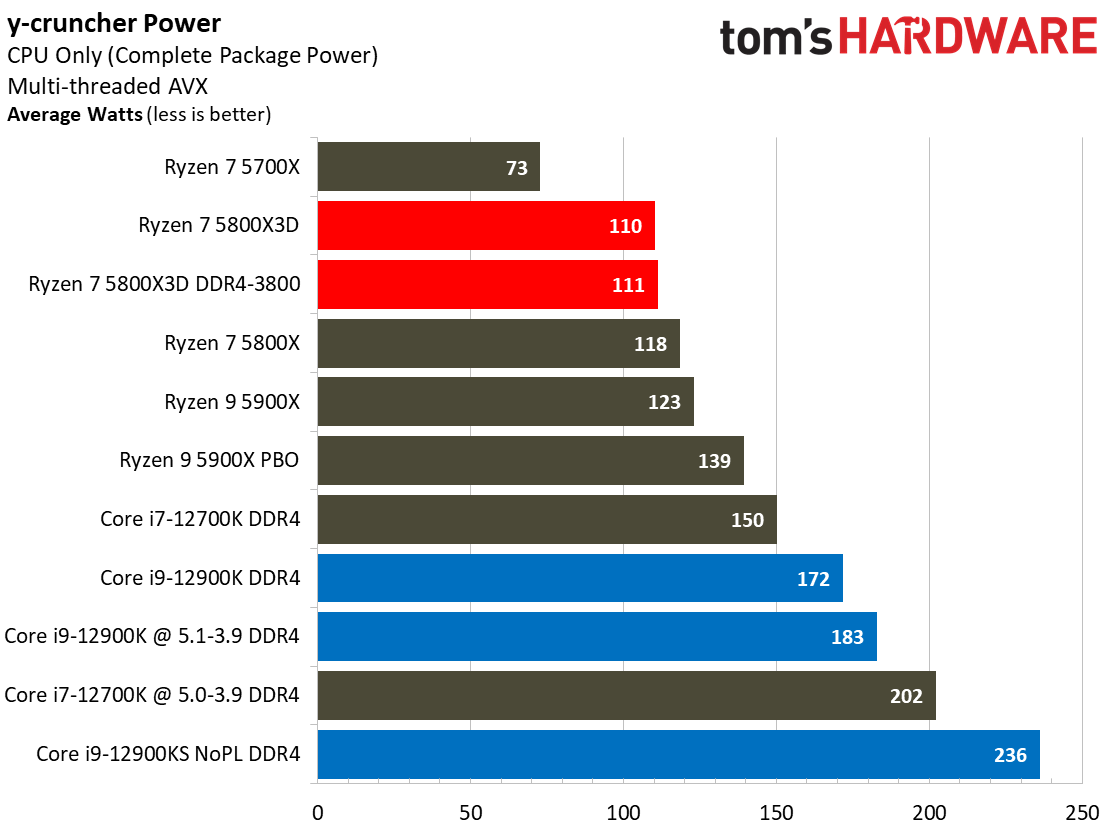
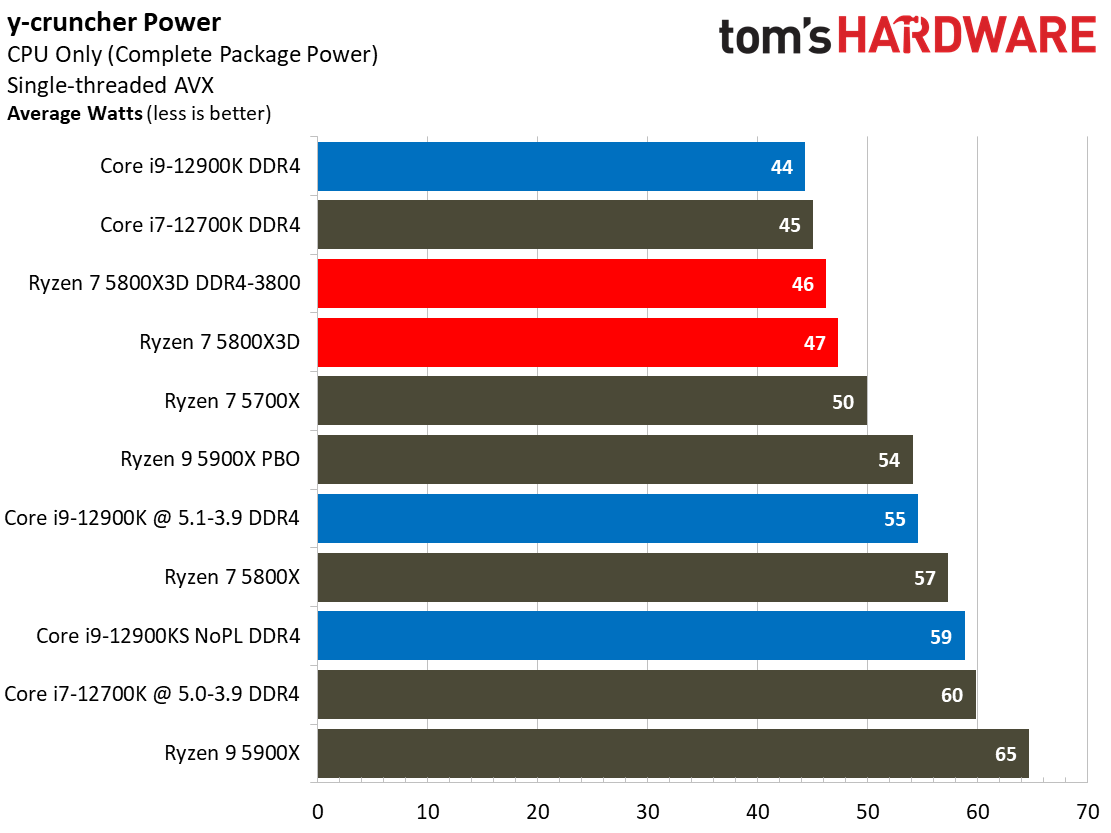
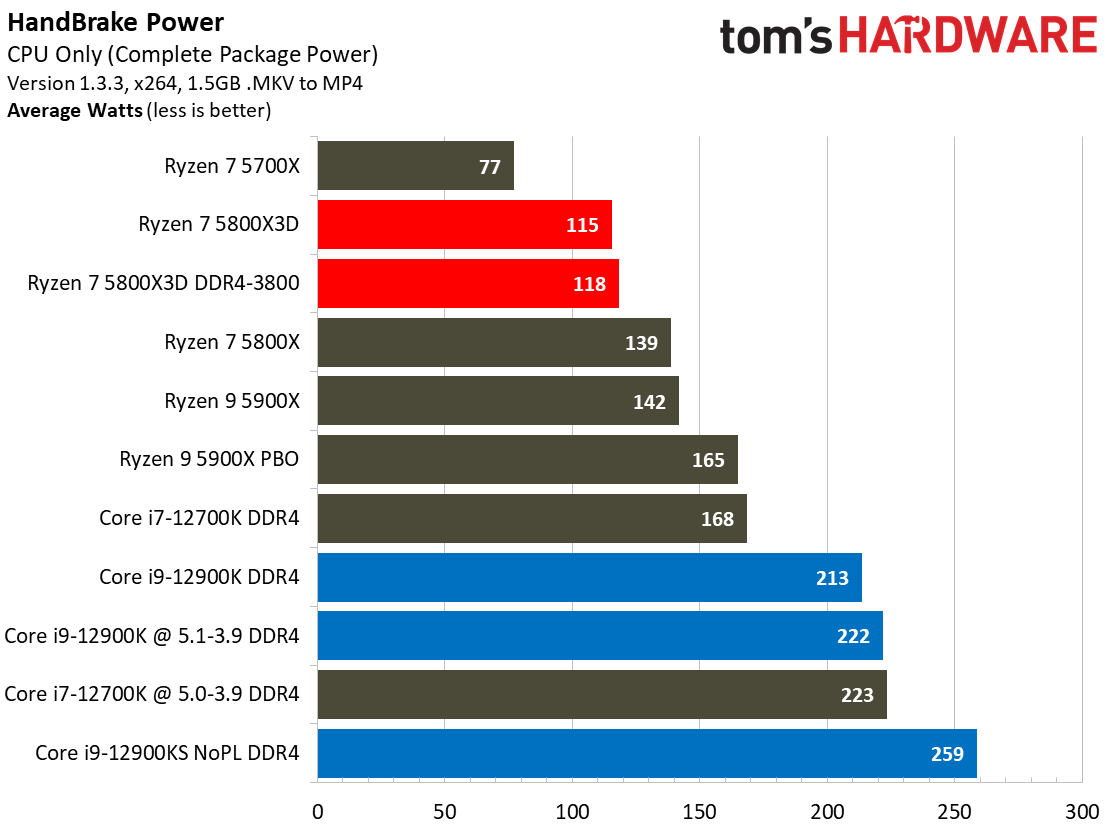
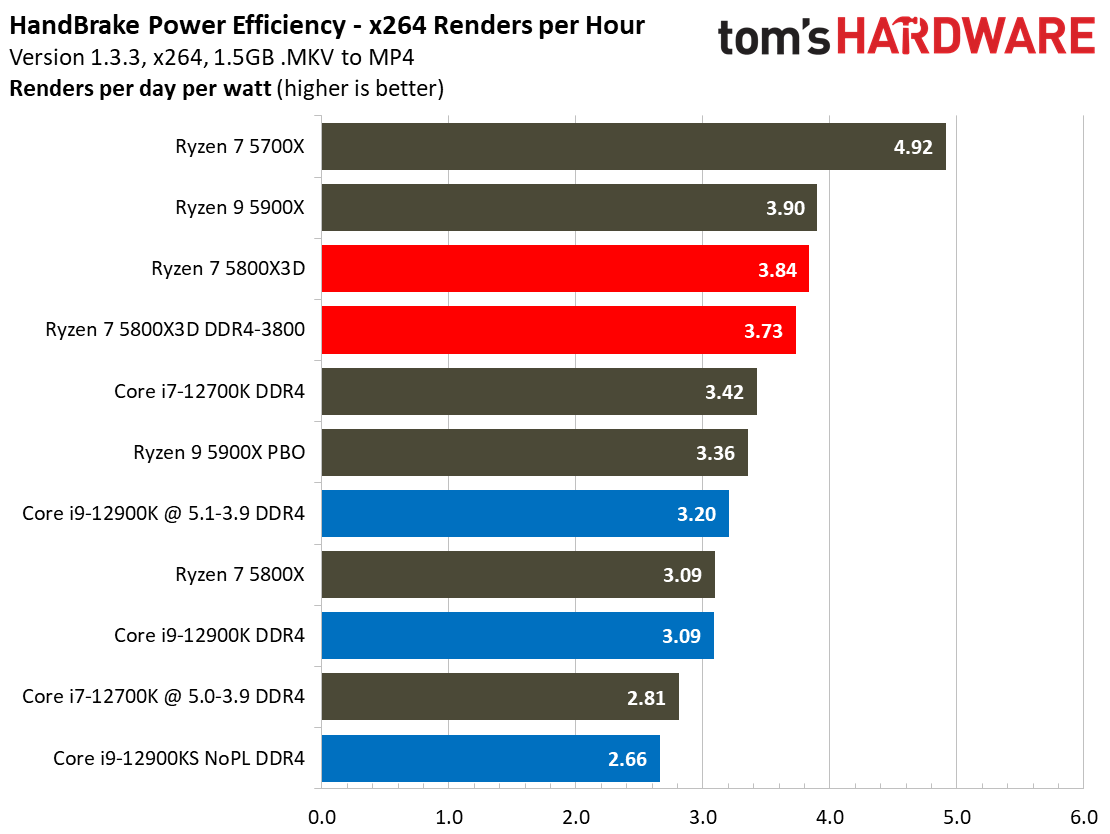

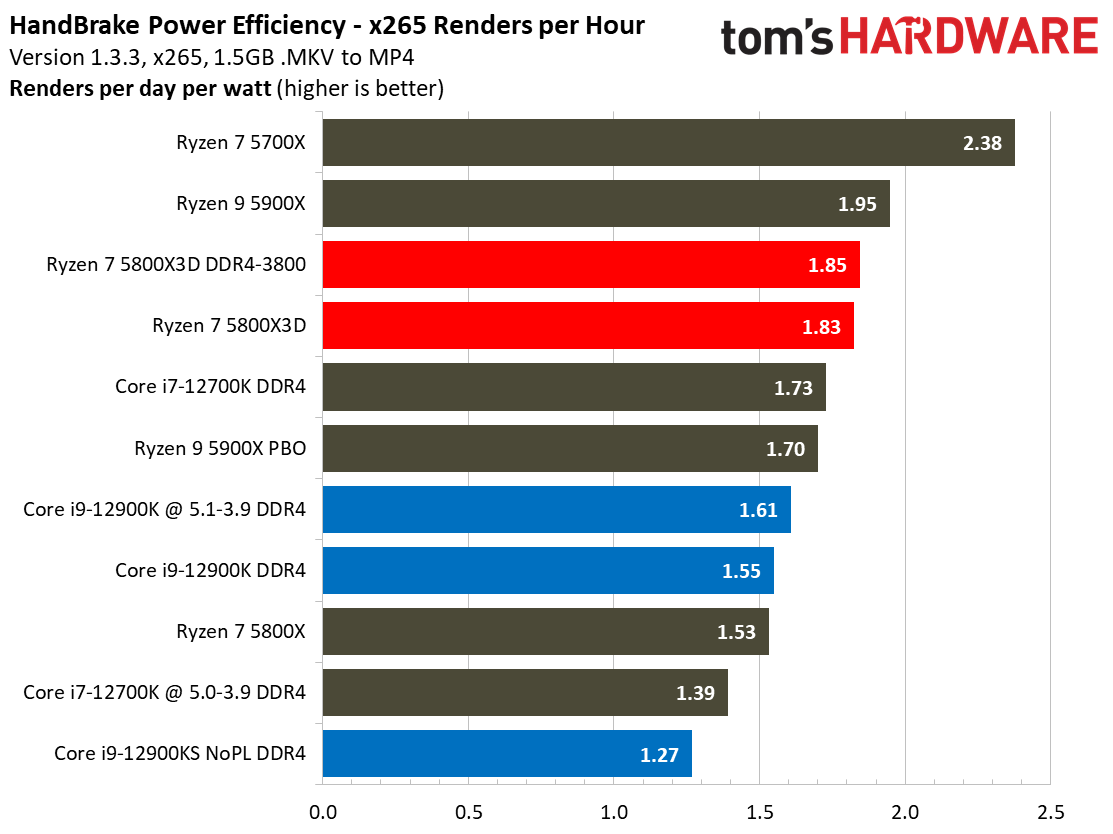

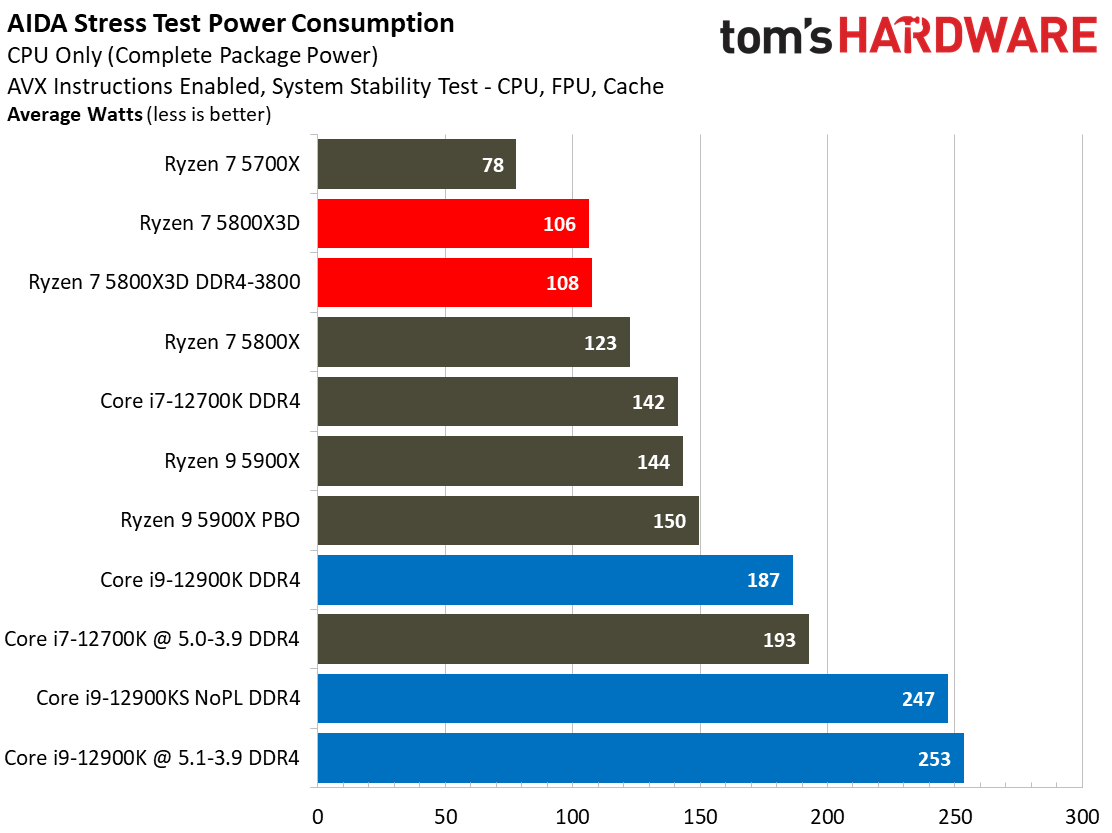
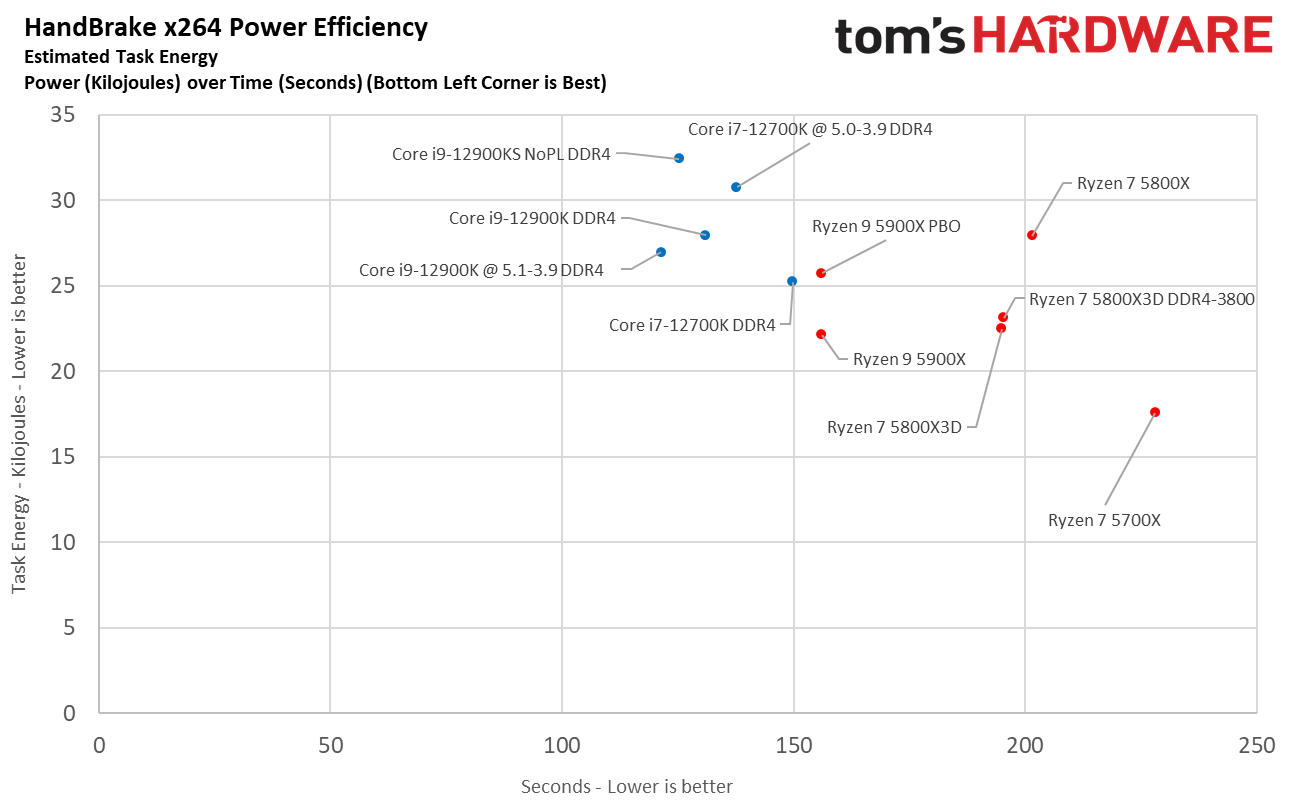

We put the Ryzen 7 5800X3D through an extensive battery of boost, power, and thermal throttling tests, of which you only see a subset of here. Be sure to check out the expanded test results in our full review.
The Ryzen 7 5800X3D continues Zen 3’s streak of providing a great power-to-performance ratio. The Ryzen 7 5800X3D consumes far less peak power than the Core i7-12700K and the Core i9-12900K in heavily-threaded work like the multi-threaded AVX-heavy y-cruncher and the synthetic AIDA stress tests, at times consuming half the power of the Intel competition.
That solid efficiency carries over to the HandBrake rendering tests, too, where we see the chip again consume less power than its rivals and also score far better efficiency in our renders-per-watt metrics.
The last four slides in the above album tell us quite a bit about power efficiency. In these charts, we calculate the cumulative amount of energy required to perform the workloads. We plot this 'task energy' value in Kilojoules on the left side of the chart. These workloads are comprised of a fixed amount of work, so we can plot the task energy against the time required to finish the job (bottom axis), thus generating a really useful power chart.
Bear in mind that faster compute times, and lower task energy requirements, are ideal. That means processors that fall the closest to the bottom left corner of those charts are best. It's easy to see that Intel has made a massive generational improvement here, but AMD still holds the advantage in all of the key power criteria, with the Ryzen 5000 models retaining the crown of the most efficient desktop CPUs that we've ever tested.
Winner: AMD
Intel has made progress, but AMD still has the most power-efficient chips. Not only do they consume less peak power, but they also accomplish more work per unit of power consumed. That results in an across-the-board win in power consumption, efficiency, and thermal output, so you'll end up with a cooler and quieter system.
None of the chips in our faceoff come with a bundled cooler, but you'll need a much better cooler to reign in the 12700K and 12900K than you will for the Ryzen processors.
Pricing: Ryzen 7 5800X3D vs Core i7-12700K and Core i9-12900K
The Ryzen 7 5800X3D lands at $449, a $100 upcharge over the Ryzen 7 5800X that comes with higher clock speeds but less cache. Like the Intel chips, the 5800X3D also doesn’t come with a bundled cooler.
If you’re strictly interested in the highest-end gaming, the Ryzen 7 5800X3D is a far better deal than the $589 Core i9-12900K – the latter costs 30% more, but the 5800X3D offers 9% more performance. The 12900K can narrow that gap significantly after overclocking, but that’s a pricey affair that requires a strong cooler and robust (read: expensive) motherboard.
Meanwhile, the 5800X3D is 13% faster than the Core i7-12700K but costs 10% more. However, the 12700K can shrink the performance gap to 3.6% after overclocking, and it doesn’t require as lavish of cooling, motherboard, and power supply accommodations as the 12900K.
The Ryzen 7 5800X3D’s real pricing advantage lies not in the cost of the silicon but in the affordable and plentiful AM4 ecosystem. AMD has enabled backward compatibility stretching all the way back to the first generation 300-series motherboards, so finding an affordable home for the 5800X3D is an easy task. In fact, first-, second-, and third-gen Ryzen upgraders can simply drop the chip into their existing motherboard, provided they have the right supporting components. That’s impossible for Intel to beat and will surely save AMD from losing some users to Alder and Meteor Lake.
That said, if you’re looking for both exceptional gaming performance and need better performance in other types of applications, too, the Core i7-12700K with a DDR4 motherboard is plenty capable and is a much better all-rounder.
Winner: AMD
The long-lived AM4 socket is both a blessing and a curse for AMD. The curse is that industry moves quickly (at least recently), and newer standards like PCIe 5.0 and DDR5 have left AM4 looking a bit dusty next to the gleaming DDR5 and PCIe 5.0 boards you’ll find for Alder Lake.
However, those same Alder motherboards can carry eye-watering price tags at the high end, and the blessing is that not a single one of them can compete on pricing with the previous-gen AM4 motherboards that you can find, well, just about anywhere. Newer AM4 boards are also less expensive than Intel’s Socket 1700 ecosystem.
In the end, the best motherboard is the one you don’t even have to buy. The 5800X3D holds the indisputable advantage here, with compatibility stretching back to most of the first AM4 models.
Bottom Line: Ryzen 7 5800X3D vs Core i7-12700K and Core i9-12900K
| Row 0 - Cell 0 | Ryzen 7 5800X3D | Core i7-12700K / Core i9-12900K |
| Features and Specifications | Row 1 - Cell 1 | X |
| Gaming | X | Row 2 - Cell 2 |
| Application Performance | Row 3 - Cell 1 | X |
| Overclocking | Row 4 - Cell 1 | X |
| Power Consumption, Efficiency and Cooling | X | Row 5 - Cell 2 |
| Pricing | X | Row 6 - Cell 2 |
| Total | 3 | 3 |
Fitting of the Ryzen 7 5800X3D’s bipolar performance attributes, we have a three-to-three tie in this AMD Ryzen 7 5800X3D vs Intel Core i7-12700K and Core i9-12900K faceoff. Oddly, that’s a much-needed win for AMD after a series of crushing defeats in every single price band at the hands of Intel’s potent, plentiful, and affordable Alder Lake processors.
The $449 Ryzen 7 5800X3D's 3D V-Cache tech represents an incredible engineering achievement that conquered the challenges of bringing the first desktop PC chip with 3D-stacked SRAM to market. The result is a comparatively low-power chip that delivers incredible gaming performance, dethroning Intel's $589 Alder Lake Core i9-12900K and $739 Core i9-12900KS from the top of our gaming charts. On average at 1080p, the 5800X3D is ~9% faster than the 12900K, which costs 30% more, and ~7% faster than the Core i9-12900KS, which costs a whopping 64% more.
That’s not to mention its lead over the $409 Core i7-12700K, either. The 5800X3D is 13% faster at 1080p than the stock Core i7-12700K, but is only 3.6% faster after overclocking both chips. The Ryzen 7 5800X3D is 10% more expensive than the 12700K, but the inexpensive AM4 ecosystem gives AMD a leg up, at least if you're specifically interested in gaming.
Overall, the Ryzen 7 5800X3D is a great high-performance gaming chip. Still, it isn’t nearly as impressive in standard desktop PC applications: The Core i9-12900K is 29% faster in single-threaded work and 62% faster in threaded applications, and the 12900KS is even faster. Additionally, the Ryzen 7 5800X is 7% faster in single-threaded work but only 1% faster in multi-threaded applications.
If you're looking for a more balanced chip that does well at both gaming and applications, the $409 Core i7-12700K is a solid choice. The Core i7-12700K is 28.8% faster in single-threaded work than the 5800X3D and 40% faster in multi-threaded work, showing that it is the best all-rounder in this price range.
The 5800X3D drops into existing socket AM4 motherboards dating back to the 300-series that debuted in 2017, making a great high-performance drop-in upgrade for Ryzen owners, provided they have a decent motherboard with solid power delivery and the right supporting components. That does come with the caveat that the 5800X3D also doesn't support Alder Lake's leading-edge connectivity options, like DDR5 and PCIe 5.0. AMD won't have comparable connectivity until its 5nm Ryzen 7000 ‘Raphael’ Zen 4 CPUs launch later this year.
If you're willing to accept the lower but still competent performance in desktop PC applications, and also do your homework to make sure the Ryzen 7 5800X3D accelerates the types of games you play frequently, it's hard to go wrong with this chip — especially for upgraders. Stepping up from a Ryzen 7 1800X to a drop-in Ryzen 7 5800X3D is a no-brainer, for instance.
We maintain that most gamers should buy Ryzen 5 or Core i5 processors for new gaming-focused builds. However, if you’re after the fastest possible performance and understand the Ryzen 7 5800X3D’s strengths and weaknesses, it’s an impressive chip that delivers leading-edge gaming performance and leaves room for future GPU upgrades, joining our list of the best CPUs for gaming.
| Intel Socket 1700 DDR4 (Z690) | Core i9-12900KS, Core i9-12900K, Core i7-12700K |
| Row 1 - Cell 0 | MSI Z690A WiFi DDR4 |
| Row 2 - Cell 0 | 2x 8GB Trident Z Royal DDR4-3600 - Stock: DDR4-3200 14-14-14-36 / OC: DDR4-3800 - All Gear 1 |
| AMD Socket AM4 (X570) | AMD Ryzen 7 5800X3D, Ryzen 9 5900X, Ryzen 7 5800X, Ryzen 7 5700X |
| ASUS ROG Crosshair VIII Dark Hero | |
| Row 5 - Cell 0 | 2x 8GB Trident Z Royal DDR4-3600 - Stock: DDR4-3200 14-14-14-36 | OC/PBO: DDR4-3800 |
| All Systems | Gigabyte GeForce RTX 3090 Eagle - Gaming and ProViz applications |
| Row 7 - Cell 0 | Nvidia GeForce RTX 2080 Ti FE - Application tests |
| Row 8 - Cell 0 | 2TB Sabrent Rocket 4 Plus - Silverstone ST1100-TI - Corsair H115i AIO - Arctic MX-4 TIM - Open Benchtable - Windows 11 Pro |
- MORE: Best CPUs for Gaming
- MORE: CPU Benchmark Hierarchy
- MORE: AMD vs Intel
- MORE: Zen 4 Ryzen 7000

Paul Alcorn is the Editor-in-Chief for Tom's Hardware US. He also writes news and reviews on CPUs, storage, and enterprise hardware.
-
shady28 So 5800X3D is really a one trick pony.Reply
Best at games, full stop, if you have something along the lines of a $1900 3090. The difference looks to be 5-10% with that GPU.
Outside of that , the 5800X3D gets shattered by the ~$80 less expensive 12700K in virtually all productivity tasks, both multi and single thread. And it's not close, like -20% not close in single thread and -30%+ in multi.
-
Makaveli Replyshady28 said:So 5800X3D is really a one trick pony.
Best at games, full stop, if you have something along the lines of a $1900 3090. The difference looks to be 5-10% with that GPU.
Outside of that , the 5800X3D gets shattered by the ~$80 less expensive 12700K in virtually all productivity tasks, both multi and single thread. And it's not close, like -20% not close in single thread and -30%+ in multi.
I guess its a good thing that AMD is marketing this as a gaming cpu and most people buying it are doing so to game and not productivity task when a higher core count model would be a better fit.
What are you really pointing out that this article doesn't cover? -
VforV Reply
He's just doing a little shilling PR for intel, don't mind him.Makaveli said:I guess its a good thing that AMD is marketing this as a gaming cpu and most people buying it are doing so to game and not productivity task when a higher core count model would be a better fit.
What are you really point out that this article doesn't cover? -
Tom Sunday ReplyVforV said:He's just doing a little shilling PR for intel, don't mind him.
To me the 5800X3D is simply a rehash or refresh of a 2021 disappearing CPU generation and clearly an apparent last minute cash grab by AMD. Besides AMD being very late to the party. A technically impressive processor and a fitting epitaph for the fledging AM4 era of AMD's Ryzen CPUs. But then being advertised as the 'fastest gaming CPU' is a moniker which serves marketing people more than it does us PC gamers. -
Roland Of Gilead Reply
It has been known since they first mentioned its release, that it only excels in gaming (if you completely discount it's already very decent multi core usage scores/metrics).shady28 said:So 5800X3D is really a one trick pony.
Best at games, full stop, if you have something along the lines of a $1900 3090. The difference looks to be 5-10% with that GPU.
Outside of that , the 5800X3D gets shattered by the ~$80 less expensive 12700K in virtually all productivity tasks, both multi and single thread. And it's not close, like -20% not close in single thread and -30%+ in multi.
The mere fact that AMD can simply add a stacked cache on top, to bring about what is essentially a generational leap in performance (over existing Ryzen models) is impressive. That's it beats Intels latest and greatest at gaming is no small feat.
Zen 4 plus 3d cache could be trouble for Intels next gen. -
VegasSmitty As an IT tech we only utilize Intel, reliable and dependable work horses. AMD are for building toys.Reply -
TerryLaze Reply
It's not like it's some super secret patent that only AMD can do, intel had released the broadwell arch 7 years ago.keith12 said:It has been known since they first mentioned its release, that it only excels in gaming (if you completely discount it's already very decent multi core usage scores/metrics).
The mere fact that AMD can simply add a stacked cache on top, to bring about what is essentially a generational leap in performance (over existing Ryzen models) is impressive. That's it beats Intels latest and greatest at gaming is no small feat.
Zen 4 plus 3d cache could be trouble for Intels next gen.
If intel chooses to they can release any CPU they want with a huge amount of cache as well, they have foveros going and now foveros direct, it's nothing difficult and they have all the r&d already done.
Losing performance in everything else plus increasing heat and loosing O/C is not a good thing for a complete line of CPUs. -
drivinfast247 Reply
Cool story! Do you feel better now that you created an account just to spout off your unsubstantiated opinion on a forum?VegasSmitty said:As an IT tech we only utilize Intel, reliable and dependable work horses. AMD are for building toys. -
VforV Reply
To me the 5800X3D is an amazing comeback of a 1.5 years old Zen3 CPU generation with just the addition of V-Cache. It completely breaks intel's and intels fanbois' narrative in half and it does so at almost half the price or even cheaper if you consider a full AL build vs just a drop in of the 5800X3D into an existing AM4 system.Tom Sunday said:To me the 5800X3D is simply a rehash or refresh of a 2021 disappearing CPU generation and clearly an apparent last minute cash grab by AMD. Besides AMD being very late to the party. A technically impressive processor and a fitting epitaph for the fledging AM4 era of AMD's Ryzen CPUs. But then being advertised as the 'fastest gaming CPU' is a moniker which serves marketing people more than it does us PC gamers.
What AMD set out to do and achieved with this CPU is exactly 100% score. Zen4 will again anger and turn intel and intel's fanbois narrative into a lie and make Raptor Lake irrelevant. See ya later, in Q3-Q4.
